Details of Russia’s nuclear modernization are inconsistent with warnings of vast nuclear expansion
While many are rightly concerned about Russia’s development and fielding of new nuclear-capable systems, a few key points about Russia’s nuclear modernization provide critical context into Moscow’s threat perceptions and strategic priorities and suggest that fears of a substantial Russian nuclear increase or change in the strategic environment might be overblown.
First, Russia’s nuclear force modernization is driven mainly by the need to replace older Soviet-era systems that are aging out. Just like every nuclear-armed state, the goal of Russia’s modernization campaign is to ensure that its forces are ready to operate in today’s environment and to support existing deterrence and strategic requirements. The initiation of these modernization programs does not necessarily depend on the adoption of a new nuclear strategy and posture but simply on when the systems were first fielded decades ago. The percentage of newer Russian nuclear systems compared to Soviet-era systems has long been an important public metric for Putin, who announced last month that 95% of Russian strategic systems had been modernized.
Second, Russia sees U.S. missile defense capabilities as a real future risk. Because of this, we see Russia developing certain capabilities that are specifically designed to challenge U.S. missile defenses. For instance, Russia reportedly plans to replace its silo-based Topol-M intercontinental ballistic missile (ICBM) by 2030 with a new “Yars-M” ICBM variant that is under development. Compared to the single-warhead Topol-M ICBM, the Yars-M system will apparently carry multiple warheads with individual propulsion systems in a parallel staging configuration, which would theoretically allow for greater survivability against missile defenses given that warhead separation would take place at an earlier stage in flight. It would also potentially allow Russia to field more warheads compared with the Topol-M system.
Additionally, we also see Russia developing hypersonic missiles that are designed to evade U.S. missile defense systems. Russia deployed upgraded SS-19 Mod 4s with its new Avangard hypersonic glide vehicle (HGV) and is also rumored to be developing new HGVs that can be fitted atop modified ICBMs. Russia is also developing a new Kh-95 hypersonic air-launched cruise missile (ALCM) and has frequently touted the “hypersonic” nature of the Kinzhal long-range, air-launched ballistic missile that can be launched from specially modified MiG-31Ks. These developments, however, are not a strategic game-changer. A ‘hypersonic’ weapon broadly means anything that travels above Mach 5, which already includes existing ICBMs. While hypersonic cruise missiles and hypersonic glide vehicles are more difficult to intercept, the United States is already developing new missile defense interceptors specifically designed to counter these capabilities, and Russia’s war in Ukraine has also proven that ‘hypersonic’ missiles such as the Kinzhal are capable of being shot down in a real-world scenario.
Notably, many of Russia’s modernization programs have also been facing serious setbacks. From the Sarmat ICBM to the Burevestnik intercontinental-range nuclear-powered, ground-launched, nuclear-armed cruise missile to the Poseidon nuclear-powered, long-range, nuclear-armed torpedo to the modernized Tu-160M bombers, many different systems are undergoing modernization programs simultaneously. On top of additional sanctions, supply chain deficiencies, and technical challenges, the concurrent development and modernization of several systems is causing significant delays to planned deployment schedules.
Russia’s modernization plans seem focused on maintaining parity with the United States and cultivating prestige, especially in the midst of its lack of success in Ukraine. Indeed, some of Russia’s new nuclear systems under development appear to mirror new U.S. systems, but their development is lagging in comparison. For example, while the United States’ new strategic bomber under development–the B-21 Raider–has completed two confirmed test flights and entered low-rate initial production, Russia’s PAK DA bomber, also taking on a flying wing design, has been marred by delays. A full prototype has yet to be completed, despite research and development starting several years before the Raider.
The threat from Russia’s tactical nuclear arsenal also appears to have been overblown. The U.S. Defense Intelligence Agency’s 2021 Worldwide Threat Assessment and the State Department’s 2023 New START implementation report stated that Russia likely possesses 1,000-2,000 tactical nuclear warheads, though the State Department estimate included retired warheads awaiting dismantlement. In 2022, some officials warned that Russia’s tactical nuclear arsenal could double by 2030. Despite these warnings, our team has observed no evidence of such an increase and have instead lowered our estimate to approximately 1,558 nonstrategic nuclear warheads. There is little authoritative public information available to support the rumors of a massive Russian increase of tactical nuclear weapons.
Despite all these developments, Russia’s current and planned force structure does not fundamentally ‘rock the boat.’ Russia’s nuclear modernization won’t change the fact that Russia still has fewer strategic launchers than the United States. Russia may be modernizing and developing new nuclear-capable systems, but it is not significantly building up its nuclear forces: Russia is replacing Soviet-era missiles with newer types on a less-than-one-for-one basis, we do not observe an increase in the number of warheads assigned for delivery by tactical forces, and we don’t see any changes in force posture on the ground. Russia’s claimed deployment of tactical nuclear weapons to Belarus is likely meant to primarily discourage the United States and NATO from further intervention in the war in Ukraine. Because of the existing presence of Russian dual-capable forces and nuclear weapons storage in the Kaliningrad region, the presence of tactical nuclear weapons in Belarus does not change the strategic environment and likely reflects a contingency plan rather than a permanent deployment.
Despite Putin’s nuclear threats during the war in Ukraine, and despite alarmist reports to the contrary, there has been no significant change in Russia’s nuclear strategy, which has largely remained relatively consistent for decades. Russia has frequently used nuclear threats in the past to try to affect geopolitics, including in regard to NATO expansion, western aid to Ukraine, and the deployment of U.S. missile defenses in Europe in 2008; however, there is no public indication that these signals necessarily portend a lowering of Russia’s nuclear threshold.
None of this is to say that Russian nuclear modernization and development is not a problem or cause for concern; Russia’s modernization of its nuclear forces, in addition to threats of nuclear action against other nations, creates ambiguity and concern surrounding Russia’s long-term intentions. Overinflation of the threat, however, will lead to miscalculation, calls for unnecessary increases to the U.S. nuclear force structure, and resistance to much-needed arms control efforts. We must be wary of letting worst-case scenario thinking push us into a dangerous arms race and unstable security situation, particularly when global tensions are so high and the United States is already planning to spend over $1 trillion on nuclear weapons programs over the next 30 years.
This research was carried out with generous contributions from the New-Land Foundation, Ploughshares Fund, the Prospect Hill Foundation, Longview Philanthropy, and individual donors.
Nuclear Notebook: Russian nuclear forces, 2024
The Federation of American Scientists has released its annual estimate of the size and makeup of Russia’s nuclear forces. The total number of nuclear warheads are now estimated to include 4,380 stockpiled warheads for operational forces, as well as an additional 1,200 retired warheads awaiting dismantlement, for a total inventory of 5,580 warheads.
Despite modernization of Russian nuclear forces and warnings about an increase of especially shorter-range non-strategic warheads, we do not yet see such an increase as far as open sources indicate. For now, the number of non-strategic warheads appears to be relatively stable with slight fluctuations. Although our new estimate of this category is lower than last year, that is not because of an actual decrease in the force level but because we have finetuned assumptions about the number of warheads assigned to Russian non-strategic nuclear forces. Our new estimate of roughly 1,558 non-strategic warheads is well within the range of 1,000-2,000 warheads estimated by the U.S. Intelligence Community for the past several years.
While Russia’s nuclear statements and threatening rhetoric are of great concern, Russia’s nuclear arsenal and operations have changed little since our 2023 estimates beyond the ongoing modernization. In the future, however, the number of warheads assigned to Russian strategic forces may increase as single-warhead missiles are replaced with missiles equipped with multiple warheads. If the New START treaty is not replaced with a new agreement, both Russia and the United States could potentially increase the number of deployed warheads.
Also in the Nuclear Notebook: Russian nuclear forces, 2024, is our latest analysis on Russian force modernization and strategy:
- Russian nuclear force modernization, intended to replace Soviet-era missiles, aircrafts, and submarines with new systems, continues at a steady pace.
- Modernization of road-mobile intercontinental ballistic missiles is essentially complete with focus shifting to modernizing silo-based missiles.
- New strategic and non-strategic submarines continue to replace Soviet-era models but with enhanced nuclear weapon systems.
- Upgrades and some reproduction of Soviet-era strategic bombers continue with new long-range cruise missiles.
- News leaks seem to indicate that Russia might be developing a nuclear-armed anti-satellite weapon which, if deployed in the future, would violate the Outer Space Treaty.
- Upgrades of nuclear weapons storage facilities are underway at several bases to accommodate the weapons for modernized forces.
- Because Russian conventional forces have been significantly depleted and their effectiveness questioned by the war in Ukraine, nuclear forces will likely be seen as important to compensate for that weakness.
The FAS Nuclear Notebook, published in the Bulletin of the Atomic Scientists, is widely considered the most accurate public source for information on global nuclear arsenals for all nine nuclear-armed states.
ABOUT FAS
The Federation of American Scientists (FAS) works to advance progress on a broad suite of contemporary issues where science, technology, and innovation policy can deliver dramatic progress, and seeks to ensure that scientific and technical expertise have a seat at the policymaking table. Established in 1945 by scientists in response to the atomic bomb, FAS continues to work on behalf of a safer, more equitable, and more peaceful world. More information at fas.org.
This research was carried out with generous contributions from the New-Land Foundation, Ploughshares Fund, the Prospect Hill Foundation, Longview Philanthropy, and individual donors.
Make Nukes History
Oppenheimer is expected to win big at the Oscars this year – and no wonder, since the film brought to life the power and horror of the 20th century’s most destructive weapon. This history gave birth to our organization – Federation of American Scientists – and last year, FAS awarded Christopher Nolan a FAS Public Service Award for his work bringing the nuclear issue back into mainstream conversation. And yet…
Nuclear weapons aren’t history.
We stand with our friends at the Nuclear Threat Initiative (NTI) who have launched an Oscar-related awareness campaign, For Your Consideration: Make Nukes History. This installation of banners in and around the Dolby Theater and online resources remind us that nuclear weapons are still an existential threat.
Here, briefly, is the work FAS is doing to address the nuclear threat still active today, and we invite you to learn more and get involved:
Nuclear Information Project
The Nuclear Information Project, called “one of the most widely sourced resources for nuclear warhead counts” by The Washington Post, is the best available unclassified estimates of the status and trends of nuclear weapons worldwide.
Through this work we remain committed to informing the public and holding our government to account. Recent examples:
- We tell the public when new nuclear capabilities are being added to our military bases (Barksdale Air Force Base) and when taxpayers foot the nuclear weapons bill exceeding estimates by billions of dollars without oversight (Sentinel ICBM program).
- We notify the public when we discover changes that could impact national defense (nuclear-capable Russian submarine fleet) and when our government wants to increase the number of nuclear weapons (Strategic Posture Report).
- We remind Americans that their vote is crucial because the U.S. President is the sole decision maker to launch a nuclear weapon!
Nuclear Notebook
We produce the Nuclear Notebook, in conjunction with The Bulletin of Atomic Scientists, on a monthly basis. Coming soon: this year’s tally of Russian weapons (March 7th).
New Voices Nuclear Weapons
Additionally, FAS is committed to supporting the next generation of nuclear weapon studies. Learn more about this fellowship.
We wish Oppenheimer success at the awards. But more importantly, we wish humanity the ability to see this issue with clarity and take action to reduce this ongoing global threat.
Get involved. Follow FAS’s work on our website and in our monthly newsletter. Contact me press@fas.org to learn more or speak with any of our nuclear weapons experts.
For Heaven’s Sake: Why Would Russia Want to Nuke Space?
It can be more than a little scary to look into the mind of a dangerous dictator like Vladimir Putin. But as Russia has several thousand nuclear weapons, managing stability and avoiding nuclear war requires that America try to understand what is happening with both the mind of the country’s leader and capabilities of its military. Deterrence is about understanding how our actions influence that of others, and vice versa. Thus, it remains essential to consider what Russia (and other adversaries) is pursuing in terms of possible contingencies, and interpret changes in military and strategic capabilities.
So when news broke in February that Russia was reportedly building some nuclear connected anti-satellite weapon, a lot of people started scratching their heads. First, because of the manner in which the news was leaked. Congressman Mike Turner seemed to get ahead of both the process and the intelligence itself, and created a bit of a panic by demanding full and immediate declassification of all information about the system. It now seems this was alarmist, and perhaps motivated by other political factors. Leaks seemed to indicate that Russia might be planning to launch a nuclear-powered anti-satellite directed energy weapon into space. U.S. officials are reportedly telling allies Russia could launch the system into space within the next year. Details became a little clearer, thanks to a public briefing by White House Advisor Adm. John Kirby. Kirby confirmed that the planned system was still in development, and President Biden later said it was not clear if and when the system would be deployed. Importantly, Kirby also stated that the system, if deployed, would violate the Outer Space Treaty of 1967. That phrase made clear that the Russian program involved placing a nuclear weapon in outer space, since deploying nuclear weapons in space is the main and only specific constraint contained in the OST.
What Can Putin Be Thinking?
We can speculate that the Russian program would involve deploying a nuclear device in orbit, presumably with some maneuvering capability so that it can be detonated to disable satellites. A nuclear explosion in space would create a series of devastating effects, including an electromagnetic pulse, and longer-lasting radiation that would circle the earth and dramatically compromise satellite communications world-wide. Some hardened assets might survive, but other unshielded military and almost all non-shielded commercial satellites would be potentially vulnerable. The global economic and communications system could be shut down or destroyed for years, and some orbits made hazardous – if not unusable – for an extended period due to space debris.
Who would do such a thing? Well, the Soviet Union and the United States considered a lot of dangerous nuclear ideas during the Cold War, including detonating nuclear weapons in outer space to blind an adversary’s space assets. The U.S. had a program in the 1960s called Casaba Howitzer, which would use nuclear explosions to drive energy beams to attack space assets. Both states tested nuclear weapons at high altitudes and considered using nuclear weapons in space. So the idea is not new. It was just rejected as reckless and dangerous for a variety of good reasons. Making space unusable is one. Leaving nuclear weapons in orbit – unprotected and out of positive human control and potentially liable to uncontrolled reentry – are two more.
So why would Russia return to this really dangerous idea now? There are at least three explanations that have some credibility (and possibly more as some of my colleagues have pointed out).
Explanation 1: Go After American Power Asymmetrically
The first plausible explanation is that in the 2000s, as Russia’s conventional military was weak and being rehabilitated, Vladimir Putin threw a lot of money at the Russia nuclear complex to come up with programs that could undermine America’s advantages. This funding led to a number of very unorthodox nuclear programs including the now famous Poseidon long-range, underwater nuclear-armed torpedo and the Skyfall, a nuclear-powered, nuclear-tipped cruise missile that can fly for days and attack its targets from unexpected angles. Both of these programs were conceived of decades ago, but did not get fully funded or deployed during the Cold War. When the USSR collapsed, these programs all withered. Both novel systems have found new support under Putin, who has touted them in multiple speeches.
The as-yet unnamed nuclear-armed satellite killer (How about Starburst for a name?) could be another such device, brought back to life from the Soviet archives to go after American power asymmetrically. As America relies heavily on space for military operations, countering it could make it easier for Russia to go toe to toe with the west in a conflict. It could be that this program was mothballed when the USSR collapsed but rehabilitated when new money was available, and details were only available recently in the later stages of development. Thus, it should not be assumed that there is a clear use strategy or specific scenario in mind behind the weapon. Both Moscow and Washington (and now some speculate China as well with its own nuclear expansion) have long histories of pursuing nuclear programs because they could, and then figuring out how to use them later.
Explanation 2: Nuclear “Insurance Policies”
A second motive is less benign than just technical and financial opportunity, and would involve Russia explicitly seeking programs and capabilities that could go after American nuclear control capabilities in a crisis to prevent America from attacking Russia first. This could be considered consistent with Russia’s stated but dangerously provocative “escalate to de-escalate strategy.” Russia’s fear is also likely behind the Poseidon and Skyfall, since both of these systems are more fittingly thought of as retaliatory, and not first strike weapons. Neither move fast enough to disarm the U.S. and are mainly good for firing after an attack. Thus, many in Russia likely consider them nuclear insurance policies; if Washington ever decided to pursue a disarming first strike made up of American conventional and nuclear assets, and backed by U.S. missile defenses (known in Russia as the splendid strike threat) enough Russian nuclear weapons would survive to destroy America, keeping deterrence intact. It is hard, and actually morally offensive, to have sympathy for Vladimir Putin, but there is a long history of fear as a motive and a sense of encirclement that permeates his regime. Thus, many of these nuclear programs – including the new nuclear armed space system – could be seen in this light. If this is an explanation for other novel nuclear systems, then it could also be part of the motive for the new space/nuclear option.
Explanation 3: Put America’s Technical Advantages at Risk
The third motive is one that probably resonates with most observers of Putin’s long and brutal time in office, marked by political assassinations and repression at home and multiple wars abroad. This possible motive is one where Putin is investing in capabilities that could cripple America in a run up to a direct conflict with Moscow. Being able to detonate a nuclear weapon in space and damage, if not destroy America’s extensive constellations of military satellites could be seen by Russia as both useful and even necessary to prepare for a possible conflict with the west and America. Its threatened use could be used to try and force America to back down in a crisis, or even used preemptively as a prelude to a major military move by Putin against NATO or America itself. As a weapon of aggression, a space-based device could put America’s considerable technical advantages at risk, thus explaining why some have expressed concern about America’s urgent need to upgrade its command and control systems and improve its resilience in space launch and satellite systems. Interestingly, in the move and counter-move process of deterrence and warfare, America’s investment in smaller, resilient constellations of satellites may have increased Russia’s interest in systems that can disable large numbers of assets as opposed to direct assent, kinetic anti-satellite weapons.
So why is Russia pursuing such a program? The bottom line is we don’t really know. Despite spending $50 billion a year on nuclear weapons, $900 billion on defense broadly, and $70 billion on intelligence, we don’t have as much insight into Russia’s nuclear doctrine or Putin’s inner thinking as we might want. All three of the motives laid out above are plausible; it’s also possible that a combination of the three are driving the Russian leader. We may never know.
Still, an important question remains regarding what the U.S. should do in response. Legally and morally, the U.S. and its allies should call out any such illegal and dangerous effort for what it is – madness. Detonating a nuclear weapon in space would not only damage U.S. assets but those of all countries, including Russia (China, India etc). It would set back the use of space for multiple purposes – peaceful and otherwise – by decades.
The Russia space program puts even greater emphasis on the need for America to insulate its space assets, diversify its systems to deal with space attacks, and develop more resilient space capabilities including through rapid relaunch abilities. In a conflict, demonstrating that the U.S. can quickly launch and replace critical space-based assets may be one way to deter Russia from ever using such a crazy and dangerous device. If doing so provides no material advantage, the need or urge to use it goes way down. Such resiliency requires considerable investment and U.S. leaders should also be mindful of an overreliance on private space launch capabilities, which while important cannot replace the Government’s own ability to protect American assets.
However this resiliency is developed – it will be expensive. But consider the money the U.S. is investing in redundant and arguably unnecessary nuclear overkill – including the new nuclear land based intercontinental ballistic missile that has now ballooned from an estimated $62B in 2015 to over $130 billion, a number which may still be climbing. Perhaps redirecting some of that nuclear funding to more urgent and useful priorities would be a better investment.
This research was carried out with generous contributions from the New-Land Foundation, Ploughshares Fund, the Prospect Hill Foundation, Longview Philanthropy, and individual donors.
Construction Of New Nuclear Weapons Facility At Barksdale AFB
Satellite images show that the Navy has begun construction of a new nuclear weapons storage and handling facility at Barksdale Air Force Base in Louisiana. The construction of this facility is part of a larger effort by the U.S. Air Force to expand the number of strategic bomber bases that can store nuclear weapons.
The Weapons Generation Facility (WGF), once complete, will reinstate the capability to store nuclear weapons at Barksdale AFB, home to the 2nd Bomb Wing with B-52H bombers. The capability was lost approximately 20 years ago when the Air Force decided to consolidate storage of nuclear air-launched cruise missiles (ALCM) to Minot Air Force Base in North Dakota.
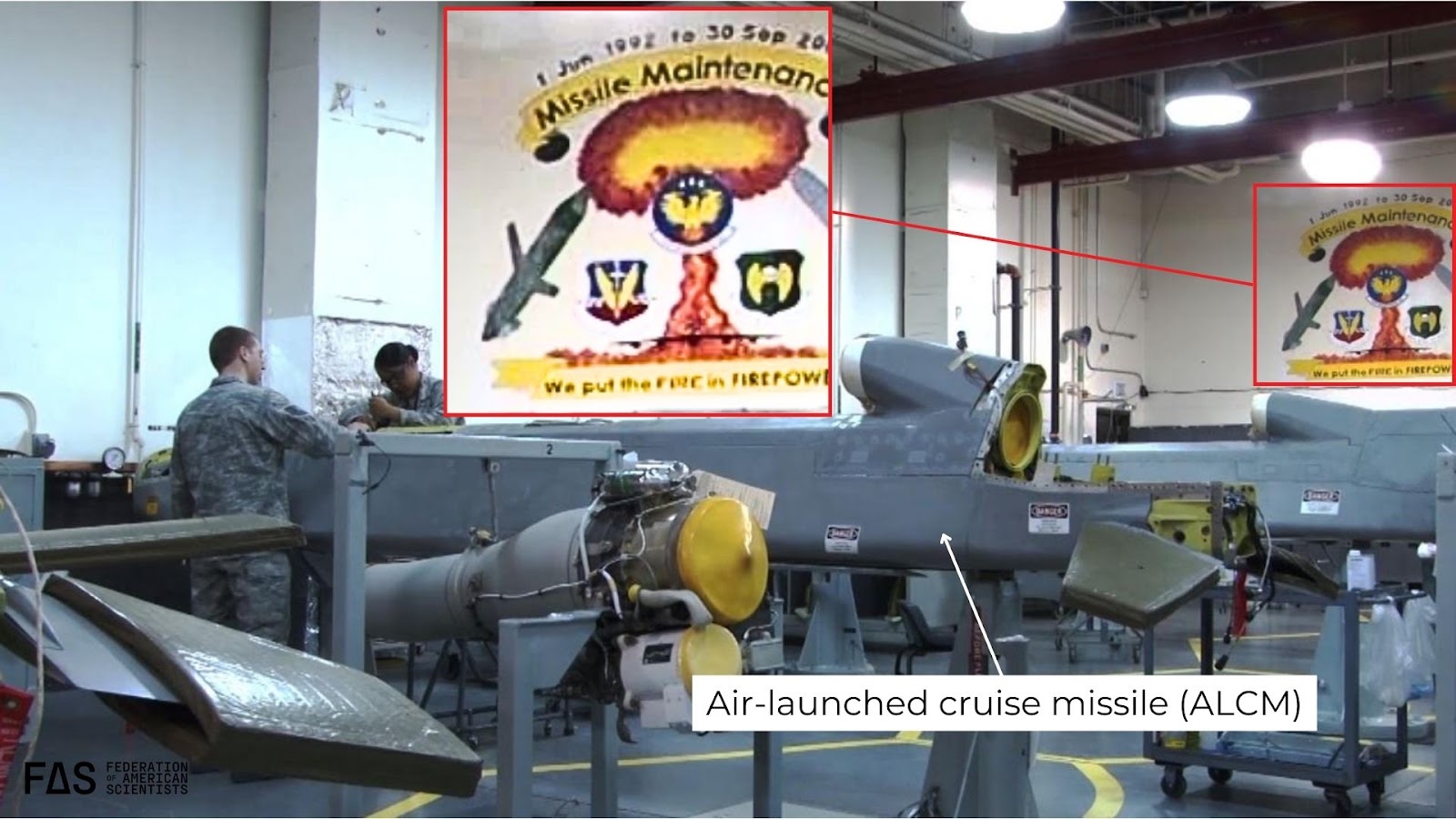
Image from US Air Force of inside ALCM maintenance facility at Barksdale AFB in 2013. The insignia on the wall shows a mushroom cloud and slogan reading “We put the FIRE in FIREPOWER.”
Our assessment that the new construction visible on satellite imagery is of the planned nuclear weapons storage and handling facility is bolstered by several open sources. A draft environmental assessment from 2017 reveals the Air Force’s plans to construct a WGF (at the time referred to as Weapons Storage and Maintenance Facilities [WSF]) at Barksdale AFB, the construction is occurring within the double-fence perimeter that housed Barksdale’s past nuclear weapons storage capability, and the construction area corresponds to the approximate size of the new complex detailed in publicly-available contract documents. Additionally, contract timelines and details correspond to activity at the site (See Figure 1), and the building foundation visible from satellite imagery corresponds to digital mockups of the facility seen in the background of photos from the WGF groundbreaking ceremony shared by DVIDS (See Figure 2).
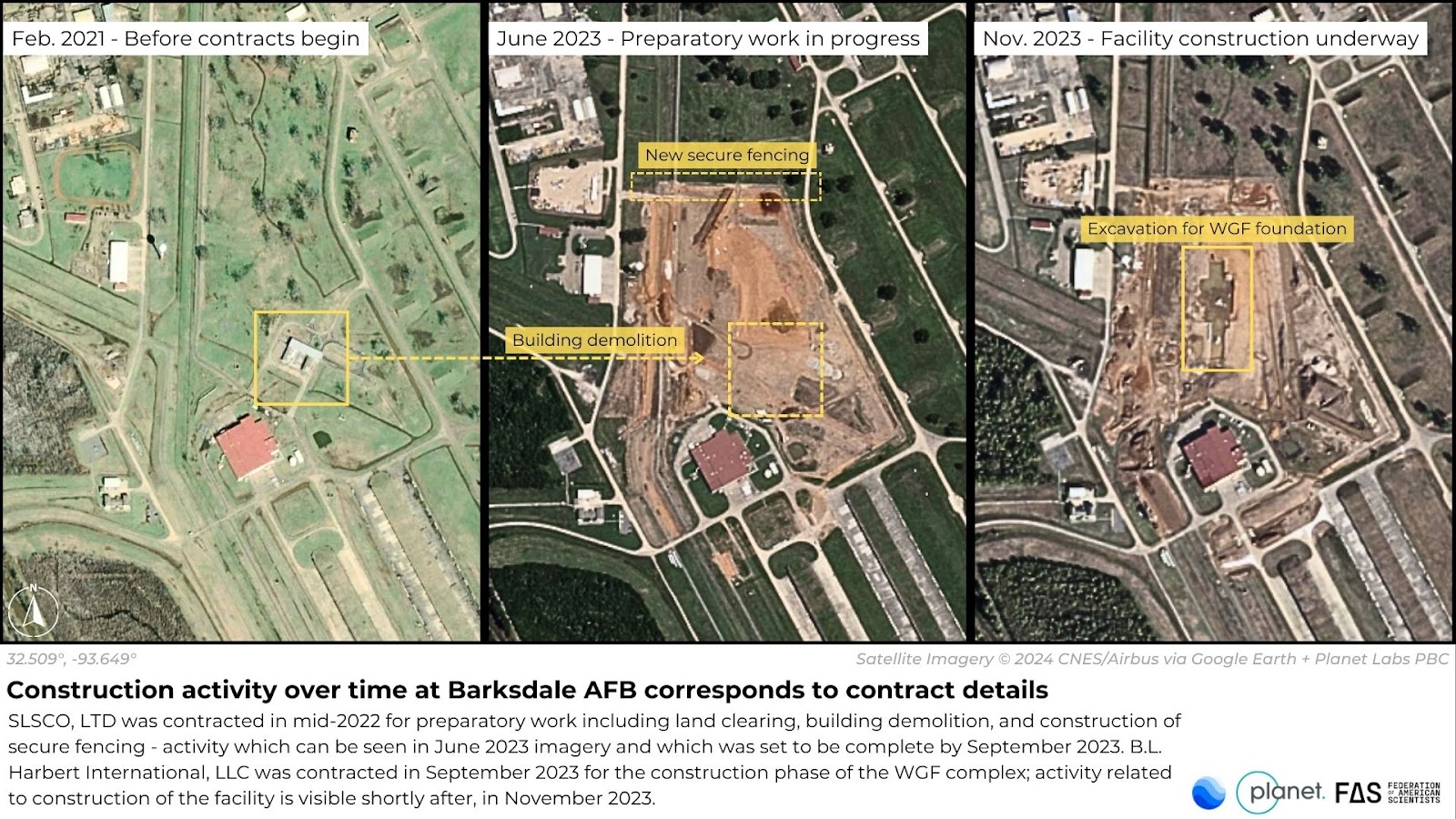
Construction activity over time at Barksdale AFB corresponds to contract details
SLSCO, LTD was contracted in mid-2022 for preparatory work including land clearing, building demolition, and construction of secure fencing – activity which can be seen in June 2023 imagery and which was set to be complete by September 2023. B.L Harbert International, LLC was contracted in September 2023 for the construction phase of the WGF complex; activity related to construction of the facility is visible shortly after, in November 2023.
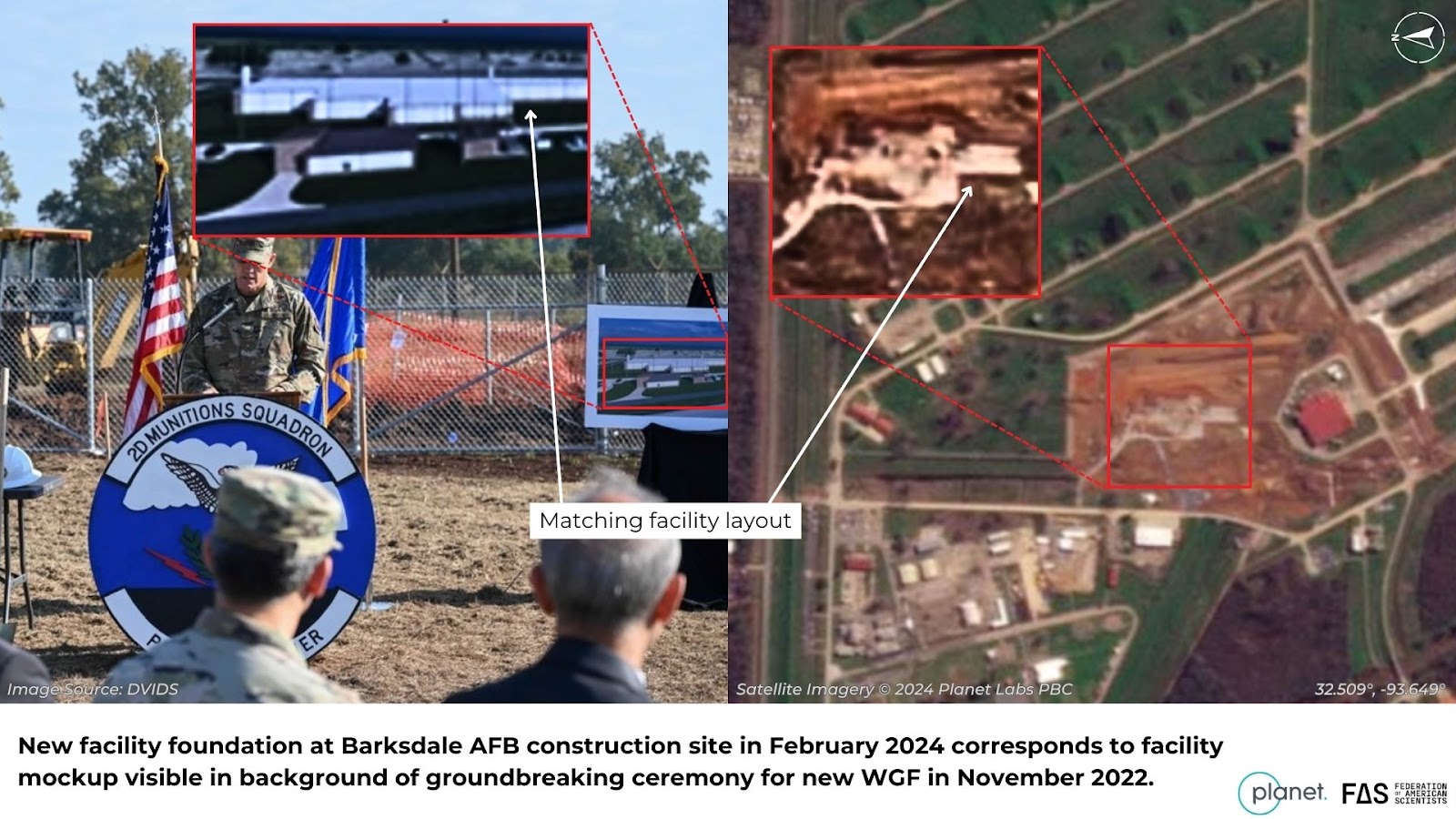
New facility foundation at Barksdale AFB construction site in February 2024 corresponds to facility mockup visible in background of groundbreaking ceremony for new WF in November 2022.
Work on the site began in mid-2022 with a $33 million contract to SLSCO, LTD to carry out site preparation via clearing, drainage, building demolition, utilities demolition and relocation, construction of secure fencing, and roadway construction, among other preparatory tasks.
Naval Facilities Engineering Systems Command (NAVFAC) awarded a $210.2 million fixed-price contract to Alabama company B.L. Harbert International, LLC in September 2023 to construct the 28-acre complex, which will include the main building, an approximately 300,000 square foot WGF; an entry control facility; security facility; fire pump building; diesel generator building; weather shelter; and multiple towers for security.
The facility, expected to be completed by January 2026, will house the new nuclear Long-Range Standoff (LRSO) cruise missiles for delivery by B-52H Stratofortress heavy bombers at the base. With the LRSO expected to achieve initial operational capability in 2030, it is possible that the Barksdale WGF will house the nuclear ALCM until it is replaced by the LRSO. The WGF at Barksdale AFB will only be used to store nuclear cruise missiles, because the B-52H bombers are no longer assigned nuclear gravity bombs.

A B-52H Stratofortress with weapons display at Barksdale AFB, showing 20 (unarmed) nuclear ALCMs on pylons and rotary launcher. Source: United States Air Force
The Weapons Generation Facilities are a new type of facility replacing the Cold War-era Weapons Storage Areas (WSA) in order to consolidate weapons storage, maintenance, and training into one building. Barksdale AFB will become the second base to receive a WGF; construction of the first is well underway at F. E. Warren AFB in Wyoming for ICBM warheads. The Air Force also plans to construct WGFs at Ellsworth AFB in South Dakota, Whiteman AFB in Missouri, and Dyess AFB in Texas for the future B-21 bomber mission.
When completed, the number of U.S. heavy bomber bases with nuclear weapons storage capability will have increased from two today (Minot AFB and Whiteman AFB) to five.
This research was carried out with generous contributions from the New-Land Foundation, Ploughshares Fund, the Prospect Hill Foundation, Longview Philanthropy, and individual donors.
Upgrades to Russia’s Nuclear-Capable Submarine Fleet
[With updated graphic] Russia is in the midst of a decades-long nuclear force modernization program intended to replace Soviet-era missiles, aircraft, and submarines with new systems. As part of this project, Russia’s Navy is currently modernizing its nuclear-powered ballistic missile submarine (SSBN) fleet and building new nuclear-powered guided missile submarines (SSGNs), along with other non-strategic nuclear-capable naval systems. The final delivery of these new strategic and non-strategic submarines to the Northern and Pacific fleets is expected to be complete by the early 2030s. FAS has tracked the progress of these developments as well as the upgrades to the supporting naval infrastructure, including submarine piers, missile loading piers, and new nuclear warhead storage facilities.
Putin commissions new nuclear-capable submarines
On 11 December 2023, Russian President Vladimir Putin traveled to the Sevmash shipyard in Severodvinsk to attend the flag-raising ceremony for two new nuclear-capable submarines. Putin’s trip to Severodvinsk came days after he declared his intention to seek another six-year presidential term.
At the shipyard, Putin oversaw the raising of the Russian Navy’s flag on the newly completed Borei-A Emperor Alexander III (K-554) SSBN and the Yasen-M Krasnoyarsk (K-571) SSGN. Putin also visited the Admiral Kasatonov frigate of Russia’s Northern Fleet, which was recently modernized to carry four Zircon hypersonic cruise missiles. A Maxar Technologies satellite captured preparations for the ceremony at Sevmash three days before Putin’s arrival.
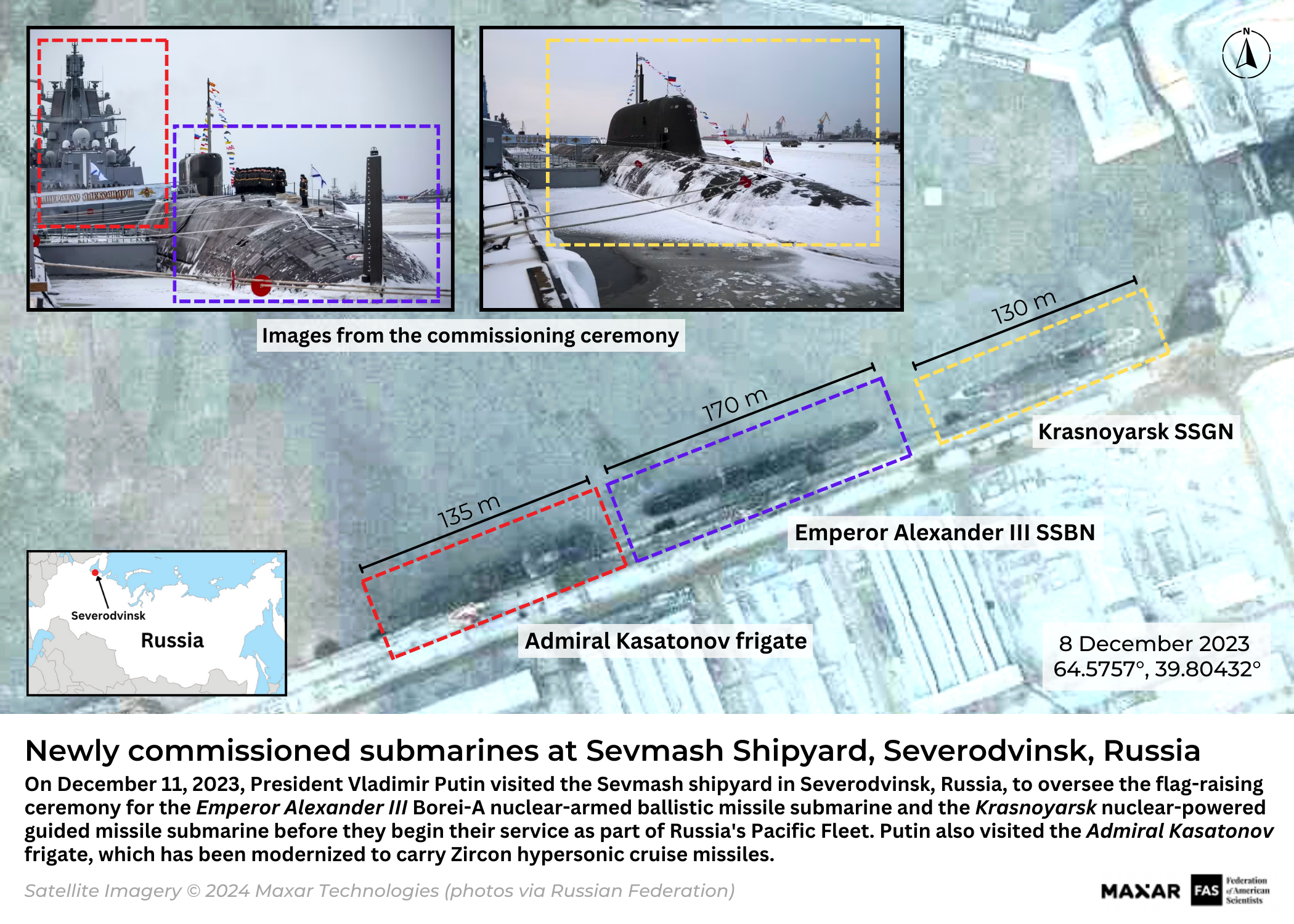
On December 11, 2023, President Vladimir Putin visited the Sevmash shipyard in Severodvinsk, Russia, to oversee the flag-raising ceremony for the Emperor Alexander III Borei-A nuclear-armed ballistic missile submarine and the Krasnoyarsk nuclear-powered guided missile submarine before they begin their service as part of Russia’s Pacific Fleet. Putin also visited the Admiral Kasatonov frigate, which has been modernized to carry Zircon hypersonic cruise missiles.
Unlike many other nuclear–armed states, it is not unusual for Putin to oversee ceremonies or drills relating to Russia’s nuclear forces. He regularly attends flag-raising ceremonies of other nuclear-powered submarines and nuclear force exercises as a signal of strength and confidence in Russian nuclear capabilities. In fact, Kremlin Spokesman Dmitry Peskov stated before a February 2022 strategic deterrence force drill that “such drills and training launches, naturally, can’t be held without the head of state,” referring to Putin’s observance of the exercise.

TOP LEFT: Putin views a strategic command post exercise in the Barents Sea in 2004. TOP RIGHT: Putin and President Belarus Lukashenko observe a February 2022 strategic deterrence forces exercise. BOTTOM LEFT: Putin attends a ceremony in December 2022 to raise the flag on the Generalissimus Suvorov SSBN and launch the Emperor Aleksandr III SSBN. BOTTOM RIGHT: Putin observes the frigate Admiral Kasatonov during the December 2023 commissioning ceremony of the Emperor Aleksandr III ballistic missile submarine and the Krasnoyarsk guided missile submarine.
While it is common for Putin to observe Russian nuclear force exercises and activities, this practice is not as customary in other nuclear-armed states. Leaders of other states will occasionally attend ceremonies or military parades that feature nuclear-capable weapons as a sign of power, but aside from in North Korea, heads of state do not regularly oversee nuclear weapons testing, exercises, and other related activities in person. Putin’s practice of uniquely observing these nuclear force drills or the commissioning of strategic weapons is presumably intended to signal the centrality of Russia’s nuclear weapons in its military doctrine.
Russian submarine fleet modernization
Submarines play a key role in Russia’s deterrence strategy, given that their stealth and survivability provide an important second-strike capability. The recent commissioning of new nuclear-powered submarines into the Pacific Fleet is a part of a larger modernization campaign as Russia’s older submarines begin to reach the ends of their service lives.
The Russian Navy currently operates two classes of SSBNs: five Delta IV (Project 667BRDM Delfin) and eight Borei (Project 955/A), five of which are the improved Borei-A (Project 955A) variant. The Emperor Alexander III––the submarine that Putin observed in December––is the seventh Borei-class submarine to enter service and the fourth of the upgraded Borei-A type. The Emperor Alexander III will be based with the Pacific Fleet located in the Kamchatka Peninsula.
Two additional Borei-A SSBNs are currently under construction, and two more are thought to be in the planning stages. Eventually, it is expected that six Borei SSBNs will be assigned to the Northern Fleet based in the Kola Peninsula, and six will be assigned to the Pacific Fleet. The new generation of Borei SSBNs will replace the Soviet-era Delta IV submarines, which are scheduled to be decommissioned throughout the late-2020s and early-2030s.
Each Borei submarine is capable of carrying 16 Bulava (SS-N-32) submarine-launched ballistic missiles (SLBMs), which can carry up to six warheads each. However, it is likely that each missile has been downloaded to four warheads to comply with the New START limit on deployed strategic warheads. Although President Putin “suspended” Russia’s participation in New START in February 2023, Russian officials subsequently stated that Russia would continue to abide by the treaty’s central limits; if so, these SLBMs presumably still carry a reduced number of warheads. This limit falls away when the New START treaty expires in February 2026 unless it is replaced with a new agreement.
A possible next generation Russian strategic nuclear submarines concept – known as “Arktur” or “Arcturus” – was unveiled at the “Army 2022” International Military-Technical Forum and could potentially start replacing the Borei-class submarines sometime after 2037. Notably, an industry official said the Arktur-class will be smaller than the current Borei-class and have a reduced number of ballistic missiles. The design concept appears to allow the submarine to also carry other weapons as well as an unmanned underwater vehicle, which would imply a multi-mission role. New SSBN variants will also likely be equipped with reactor technology that extends the amount of time required between refueling, which will significantly shorten midlife maintenance operations and allow for more submarines to be on patrol at the same point in time.

In addition to strategic SSBNs, the Russian Navy operates sea-based nonstrategic nuclear weapons, including land-attack cruise missiles, anti-ship cruise missiles, torpedoes, and more, which can be launched from naval systems such as aircraft carriers, cruisers, frigates, corvettes, naval aircraft, and guided missile submarines such as the Krasnoyarsk––the other submarine that Putin observed in December.
The Russian Navy is also building submarines specially configured to carry a new nuclear-powered, long-range, nuclear-armed torpedo called Poseidon. The first of these submarines—Project 09852 Belgorod (K-329)—was delivered to the Russian Navy in July 2022 and reportedly will be capable of carrying up to six Poseidon torpedoes. The second submarine—Project 09851 Khabarovsk—is in the final stages of construction at the Sevmash Shipyard and will also reportedly carry up to six Poseidon torpedoes. One more specially configured submarine is planned to be delivered to the Russian Navy by 2027, for a total of at least three Poseidon-capable submarines.
Upgrades to Pacific Fleet infrastructure
A new division of specially configured submarines will reportedly be stationed with the Pacific fleet by the end of 2025. To support this expansion, as well as the additions of the Krasnoyarsk, Emperor Alexander III, and eventually more Borei submarines, infrastructure at the Pacific Fleet naval base in Kamchatka is undergoing significant renovations. In the past several years, Russia has added additional storage at the missile and warhead depots and begun construction of a new pier. These projects can be seen from satellite imagery captured by Planet Labs PBC.
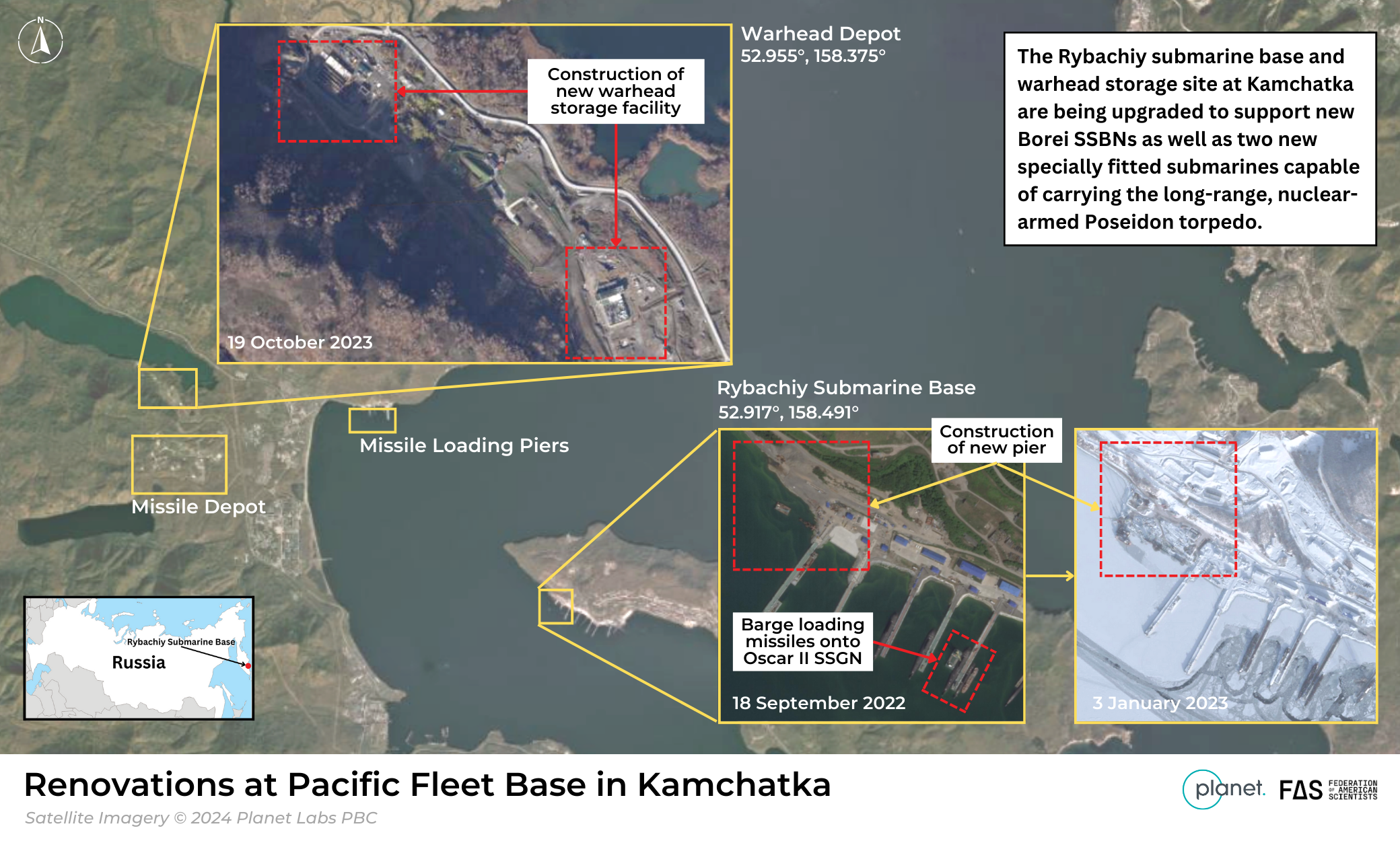
The Rybachiy submarine base and warhead storage site at Kamchatka are being upgraded to support new Borei SSBNs as well as two new specially fitted submarines capable of carrying the long-range, nuclear-armed Poseidon torpedo.
While upgrades to the existing warhead storage facilities at the Rybachiy submarine base in Kamchatka began sometime after August 2013, construction of a new underground warhead storage facility began in early 2020 and is ongoing. The existing storage facility was built to accommodate warheads for now-decommissioned Delta III submarines, but those missiles could only carry three warheads on each missile. Since the new Borei SSBNs will be able to carry up to six warheads on each of its 16 SLBMs, the new facilities are likely meant for the Pacific Fleet to accommodate additional warheads as Russia completes the modernization of the submarine fleet in the coming years.
This new storage addition is also particularly interesting because of its unique design – the facility has a different layout than existing Russian naval warhead storage facilities in the Pacific and Northern Fleets and seems to be designed similarly to what the U.S. Navy has built for its Pacific SSBN fleet.
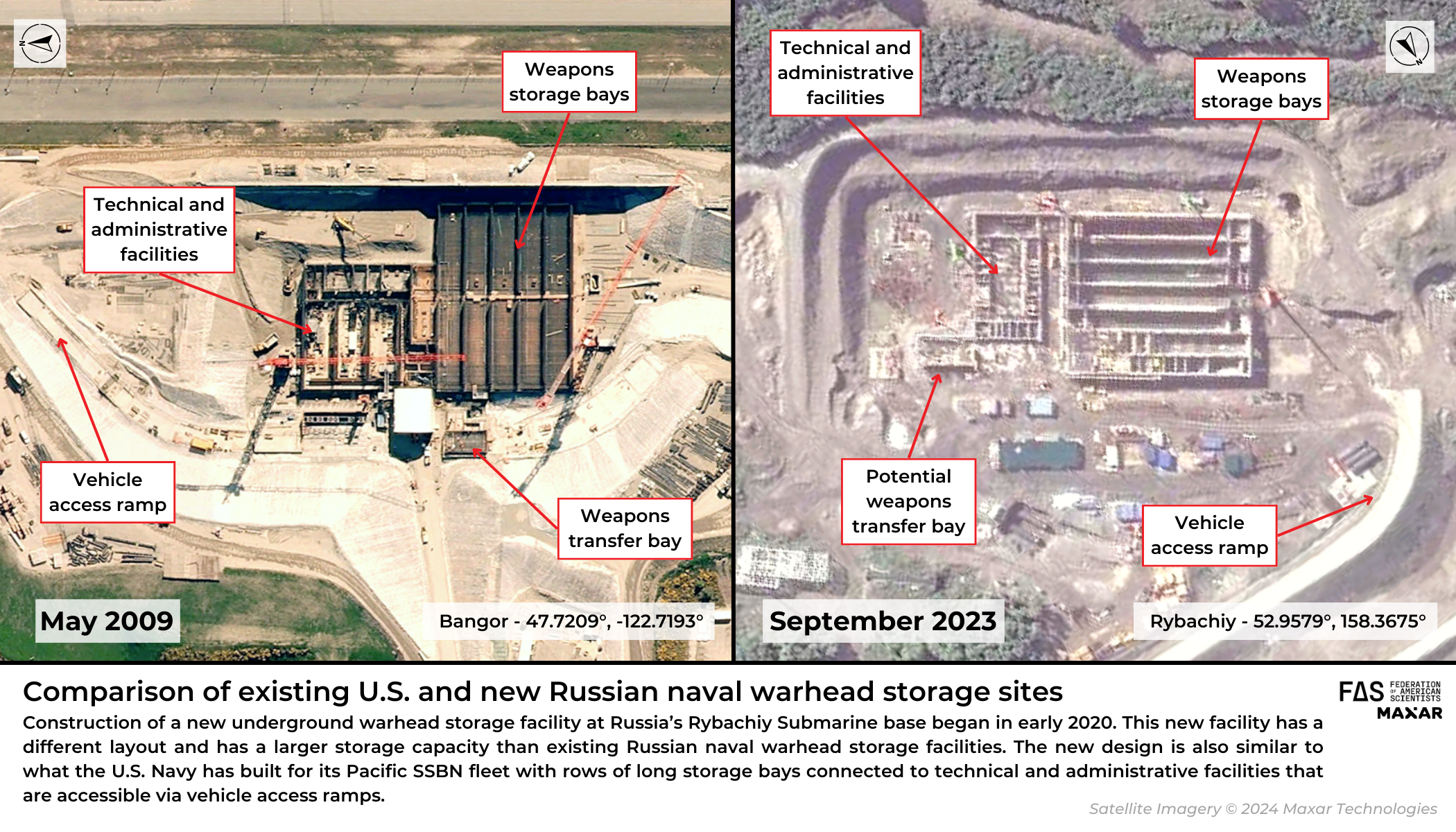
Construction of a new underground warhead storage facility at Russia’s Rybachiy Submarine base began in early 2020. This new facility has a different layout and has a larger storage capacity than existing Russian naval warhead storage facilities. The new design is also similar to what the U.S. Navy has built for its Pacific SSBN fleet with rows of long storage bays connected to technical and administrative facilities that are accessible via vehicle access ramps.
This research was carried out with generous contributions from the New-Land Foundation, Ploughshares Fund, the Prospect Hill Foundation, Longview Philanthropy, and individual donors.
“Critical” Overrun of Sentinel ICBM Program Demands Government Transparency
On January 18th, the Air Force notified Congress that its program for the new Sentinel intercontinental ballistic missile (ICBM) being developed by Northrop Grumman will cost 37 percent more than projected and take at least two years longer than estimated–an overrun in ‘critical’ breach of Congress’s Nunn-McCurdy Act. Transparency from the Department of Defense and Congress over the following months will be crucial to understand the causes and consequences and ensure proper public oversight of one of the largest nuclear weapons programs in U.S. history.
What caused the overrun?
While Air Force officials have cited inflation and unexpected infrastructure costs related to command and launch as the primary causes of the overrun, skewed cost estimates since the program’s inception and consequences of unhealthy practices related to industry competition are likely to blame as well.
Infrastructure costs
According to Andrew Hunter, Assistant Secretary of the Air Force for Acquisition, Technology, and Logistics, there has been a slight increase in cost of the missile itself, but the cost and schedule growth for the project is largely due to supporting infrastructure costs. The Sentinel program includes not only an entirely new long-range missile but replacement or enhancement of silos, launch command centers, and command and control facilities for the ICBM force. For example, the silos and launch facilities for Sentinel will be significantly larger than for the Minuteman missiles. Additionally, the Air Force had planned to reuse the communications infrastructure from Minuteman III for Sentinel but determined that the system was too old to fully function with the new ICBM, requiring completely new cabling. Kristyn Jones, acting Under Secretary of the Air Force, similarly cited the “massive ‘civil works’ project” as the primary overrun cause.
The Government Accountability Office (GAO)’s annual evaluation of Pentagon weapons programs in June 2023 additionally revealed that the Sentinel program was delayed because Northrop Grumman is experiencing staffing shortfalls, clearance delays, IT infrastructure challenges, and supply chain disruptions. Northrop Grumman was issued a sole-source, $13.3 billion contract for the program in September 2020.
Skewed cost estimates
A 2016 Air Force cost analysis for the Sentinel program (previously known as the Ground Based Strategic Deterrent or GBSD) concluded that replacing the existing force of Minuteman III ICBMs would be cheaper than a life-extension program. The assumptions that led to this assessment, however, were flawed and potentially skewed to favor a full replacement of the ICBM program.
The primary factor leading to the Air Force’s determination that a life-extension of Minuteman ICBMs would be more expensive was the requirement from their Analysis of Alternatives that the ICBM force level be maintained until 2075. This arbitrary requirement for force levels and timeline meant that a life-extension program for Minuteman III ICBMs would have to include the cost of building a follow-on missile to reach the 2075 requirement, ensuring a favorable look for Sentinel. Projections for a program lifespan before or after 2075–like 2050 or 2100–result in cheaper cost estimates for life-extension of Minuteman than development of Sentinel.
As recently as 2021, Air Force Global Strike Command claimed the Sentinel program would be $38 billion cheaper than attempting to upgrade and extend the life of the Minuteman III. After the “critical” cost projection increase was made public, the Air Force insisted that “There is not a viable service life extension program that we can foresee for Minuteman III. It was fielded in the 70s as a 10-year weapon,” even though the Air Force put the Minuteman III through a complete life-extension a decade ago.
The Air Force’s first cost estimate for the Sentinel program in February 2015 was $62.3 billion (in then-year dollars). Just nine months later, the Pentagon’s cost estimation team put the number between $85 billion and $100 billion, already over one-third higher than the original estimate. After setting the estimate at $85 billion in 2016, the Air Force again increased the estimated program cost in 2020 to $95.8 billion. With the recently reported cost overrun of 37 percent, the latest cost estimate for the program––scheduled for release this year––could jump to more than $130 billion.
The Air Force knew that the low cost projection that was used to secure Congressional approval and lock the program in was made with incomplete data. After the newest cost increase was disclosed, the Air Force acknowledged: “Some of the assumptions that were made at the beginning of the program when the initial cost estimates were made were just not particularly valid, and now we have a lot more information that should allow us to stay much closer to the cost estimates that will be developed as part of the Nunn-McCurdy process.”
Industry and competition
One persistent justification for Sentinel voiced by the Air Force is that a new missile program would help protect the large solid rocket motor (LSRM) industrial base that has suffered from consolidation in recent years. In 2018, Northrop Grumman–one of just two competitors for the Sentinel program alongside Boeing–purchased Orbital ATK, one of the two remaining LSRM manufacturers. This acquisition gave Northrop Grumman a significant advantage over Boeing, who ultimately withdrew from the Sentinel competition in 2019, citing “inherently unfair cost, resource and integration advantages.”
With Boeing declining to bid, Northrop Grumman became the sole contract winner for the Sentinel program. Ultimately, the Air Force’s failure to mitigate anti-competitive behavior by Northrop Grumman and its awarding of an unprecedented high-value sole-source contract likely contributed to higher costs for the Sentinel program and a more unhealthy industrial base.
The Nunn-McCurdy process
The Air Force is required to provide the overrun notification to Congress due to the Nunn-McCurdy Act, which mandates that the Pentagon disclose to Congress if a program faces cost or schedule overruns exceeding 15 percent. With a cost overrun of 37 percent, the Sentinel program is in “critical” breach of the Nunn-McCurdy Act, requiring the Secretary of Defense to conduct a root-cause analysis and renewed cost assessment. Following completion of these requirements, the program will be terminated unless the Secretary of Defense certifies the program no later than 60 days after a required Selected Acquisition Report is submitted to Congress.
Secretary of Defense Lloyd Austin will engage in these processes over the next several months to uncover the cause of the cost overrun and assess, alongside the Pentagon’s Director of Cost Assessment and Program Evaluation. Together, they will determine:
- the estimated cost of the program if no changes are made to the current requirements,
- the estimated cost of the program if requirements are modified,
- the estimated cost of reasonable alternatives to the program, and
- the extent to which funding from other programs will need to be cut to cover the cost growth of this program.
The certification required to keep the program alive must then certify, in the exact words of the legislation, that: [author context and commentary added below]
- the program is essential to national security, [How will Secretary Austin certify this? Expert analysis has identified cheaper and more efficient alternatives to the Sentinel program and challenged the necessity of ICBMs in the U.S. arsenal.]
- the new cost estimates have been determined by the Director of Cost Assessment and Program Evaluation to be reasonable, [What is the standard for ‘reasonable’? Will this determination consider cheaper alternatives to the Sentinel program, such as a life-extension program of the Minuteman III ICBM? The details of this determination should be made public to ensure proper oversight, given that a Pentagon official will be making the determination for a defense program.]
- the program is a higher priority than programs whose funding will be reduced to cover the increased cost of this program, and [What programs will be cut to pay for the Sentinel program? Will only other defense programs be at risk? That information and the method of determining priority should be available to the public.]
- the management structure is sufficient to control additional cost growth. [The continuous delays and cost growth of the Sentinel program reveal a persistent failure in program management. Any certification presented by Secretary Austin must address this failure and explain how the management structure will be altered to address it.]
If the program avoids termination, the Nunn-McCurdy Act requires that it be restructured to rectify the root cause of the overrun and receive new milestone approval. Even before the review has been completed, the Air Force argues the Sentinel program will not be canceled: “Sentinel will be funded. We’ll make the trades that it takes to make that happen.” Those “trades” may include reduction or even cancellation of other programs or asking Congress to further increase the defense budget.
Implications for force structure
Although the news and forthcoming processes related to the Sentinel overrun are largely focused on cost, the two-year schedule overrun could have critical implications for U.S. nuclear force structure as well.
Pentagon documents have previously indicated that a two-year programmatic slippage could result in up to 35 ICBMs being removed from alert status. While several analysts have questioned the continued U.S. requirement for 400 deployed ICBMs, a provision included in each National Defense Authorization Act (NDAA) since FY 2017 legally prohibits the number of deployed ICBMS from dropping below 400. The 2023 Congressional Strategic Posture Commission appeared to acknowledge a possible dip in the ICBM number by recommending the Air Force plan to deploy the Sentinel in a MIRVed configuration.
In order to prevent this slippage, according to senior Air Force and Northrop officials, the two-year delay in achieving initial operational capability (IOC) means the Air Force will have to life-extend some Minuteman III ICBMs, something senior officials have previously argued was not possible. In defense of the Sentinel program in 2021, then-Commander of USSTRATCOM Adm. Charles Richard said, “you cannot life extend the Minuteman 3,” and argued the system is “so old that in some cases the drawings don’t exist any more.” While Sentinel is meant to replace the Minuteman missiles, the two programs will have to operate simultaneously for some time due to the delay, which will add additional cost. This delay also puts Sentinel’s IOC beyond the no-fail IOC date of September 2030 set by Air Force Global Strike Command.
Incomplete data, rosy cost projections, and excessive secrecy appear to have combined to push the Sentinel program deep into the red. Institutional preference of getting a new weapon system rather than operating an existing missile for another decade or two has probably been another factor; the technical-cost assessment of a Minuteman III life-extension has never been made public.
The Pentagon and/or Congress should make all steps and results of this Sentinel review process open to the public to ensure maximum transparency, scrutiny, and oversight. Secretary Austin’s likely certification of the Sentinel program should be open to public interrogation, and Congress must thoroughly examine whether every certification requirement is met. Congress should ask the Government Accountability Office and Congressional Budget Office to make independent reviews. The Sentinel program has been plagued with cost increases, flawed assumptions, and misleading arguments from the beginning; this most recent overrun demands a reassessment of the Pentagon’s justification for Sentinel and hawk-eyed scrutiny of the program’s next steps.
This research was carried out with generous contributions from the New-Land Foundation, Ploughshares Fund, the Prospect Hill Foundation, Longview Philanthropy, and individual donors.
Chinese Nuclear Forces, 2024: A “Significant Expansion”
The Federation of American Scientists’ Nuclear Information Project, a component of the Federation’s Global Risk program, today released its latest assessment of China’s growing nuclear arsenal: the 2024 Nuclear Notebook on Chinese Nuclear Forces. The 24-page report, published in the Bulletin of Atomic Scientists, includes details on China’s nuclear weapons arsenal, including types of weapons, delivery vehicles, operations, and, importantly, questions that can help determine the reliability and accuracy of projections about the future growth of China’s nuclear capabilities.
The Notebook comes at a critical time for U.S. analysis and policy debates regarding China’s nuclear forces and the appropriate U.S. and allied response. In October 2023, the Pentagon released its annual report to Congress on Military and Security Developments Involving the People’s Republic of China. This report preceded the release of both the Strategic Posture Commission report and the State Department’s International Security Advisory Board report on Nuclear Deterrence in a World of Nuclear Multipolarity. Within the U.S. government, military, and national security community, analysts are evaluating the implications of China’s growing nuclear force for nuclear deterrence, global stability, and U.S. security commitments in East Asia, Europe, and beyond.
What about the DOD’s numbers?
Meanwhile, the 2024 Nuclear Notebook on Chinese nuclear forces comes on the heels of a news report from Bloomberg that suggest corruption in China’s military procurement program may have resulted in the production or delivery of nuclear-tipped missiles and missile silos that do not operate properly. Reports about China’s corruption are not new, but the potential impact on the unprecedentedly rapid projected growth of China’s nuclear forces has not been previously reported, nor has it been reflected in reports, testimony, or statements by top Administration, defense, or intelligence officials.
Given the potential implications of the Bloomberg report, FAS sent a letter to Secretary of Defense Lloyd Austin asking whether the reported intelligence about the reliability of China’s missile force was known to the authors of DOD reports on China’s nuclear program and, if so, why they were not reflected in reports sent to Congress. As one of the most authoritative non-governmental sources on global nuclear forces, FAS has a unique interest in ensuring that its reports are objective and reflect the full extent of government and non-governmental expert understanding of nuclear arsenals worldwide.
2024 Nuclear Notebook: Key findings on China’s nuclear forces
Analyzing and estimating China’s nuclear forces is challenging, particularly given the relative lack of state-originating data and the tight control of messaging surrounding the country’s nuclear arsenal and doctrine. Like most other nuclear-armed states, China has never publicly disclosed the size of its nuclear arsenal or much of the infrastructure that supports it. The analyses and estimates made in the Nuclear Notebook are derived from a combination of open sources, including (1) state-originating data (e.g. government statements, declassified documents, budgetary information, military parades, and treaty disclosure data), (2) non-state-originating data (e.g. media reports, think tank analyses, and industry publications), and (3) commercial satellite imagery. From this information, FAS has tracked the significant expansion of China’s ongoing nuclear modernization program. Key findings from the 2024 FAS assessment on Chinese nuclear forces include:
- China’s nuclear expansion is among the largest and most rapid modernization campaigns of the nine nuclear-armed states.
- FAS estimates that China has produced a stockpile of approximately 500 nuclear warheads, with 440 warheads available for delivery by land-based ballistic missiles, sea-based ballistic missiles, and bombers.
- The latest Pentagon projection appears to apply the same growth rate of new warheads added to the stockpile between 2019 and 2021 to the subsequent years until 2035. FAS assesses that this projected growth trajectory is feasible but depends significantly upon many uncertain factors and assumptions.
- China has continued to develop its three new missile silo fields for solid-fuel intercontinental ballistic missiles (ICBMs), expand the construction of new silos for its liquid-fuel DF-5 ICBMs, and has been developing new variants of ICBMs and advanced strategic delivery systems.
- China has further expanded its dual-capable DF-26 intermediate-range ballistic missile (IRBM) force, which appears to have completely replaced the medium-range DF-21 in the nuclear role.
- China has been refitting its Type 094 ballistic missile submarines with the longer-range JL-3 submarine-launched ballistic missile (SLBM).
- China has recently reassigned an operational nuclear mission to its bombers and is developing an air-launched ballistic missile (ALBM) that might have nuclear capability.
This research was carried out with generous contributions from the New-Land Foundation, Ploughshares Fund, the Prospect Hill Foundation, Longview Philanthropy, and individual donors.
What Did the DOD Know About Chinese Missiles in the Latest PRC Nuclear Capabilities Report?
The Federation of American Scientists (FAS) sent a letter on January 9, 2024, to Secretary of Defense Lloyd Austin regarding the Department of Defense’s recent publications on China’s nuclear arsenal. These publications are a primary source of information for the public and are widely referenced by the U.S. government, military, and national security community when discussing the scope and implications of China’s nuclear modernization.
In early January 2024, Bloomberg published a press report suggesting U.S. intelligence assessments have evidence that the reliability of China’s new nuclear missiles may be undermined by corruption within China’s People’s Liberation Army Rocket Forces. These assessments cited examples of significant flaws in China’s missile program, including missile silo lids that may not be fully operational and missile silo fields – some of which were originally discovered by FAS researchers – that may have stages or components filled with water instead of fuel. If true, these flaws would compromise missile operations, calling into question China’s nuclear force readiness and overall capabilities.
FAS noted that “For over 70 years, FAS has worked to ensure there is a vigorous and informed public debate over nuclear weapons and security. As the world’s leading non-governmental source of information about global nuclear arsenals, ensuring the public has reliable and accurate information about the scale, role and capabilities of nuclear forces in other countries is critical to that debate.”
The letter sent by FAS asks whether these assessments were known to the authors of DOD reports to Congress who expressed concern about the record pace of China’s nuclear deployments and production. If so, the letter asks why such assessments were not included in those DOD reports or in other testimony and statements by DOD officials and military officers.
Finally, the letter notes FAS’ historical interest in ensuring U.S. government assessments about nuclear forces are complete and unbiased.
We have reproduced the text of the letter below. You can also download it as a PDF using the button on the top left of this post.
Secretary Lloyd Austin
The Department of Defense
Dear Mr. Secretary:
On January 6th, 2024, Bloomberg News reported that U.S. intelligence assessments called into question the reliability and functionality of China’s growing arsenal of long-range nuclear-armed missiles. The article mentioned that some silo doors on ICBMs may function properly, and ICBM stages or components may have been filled with water. None of this information has been included or publicly cited in reports or speeches by U.S. Defense Department officials or military officers, even as public concern about the pace of China’s reported nuclear buildup has increasingly influenced U.S. thinking about both deterrence, alliance management, and nuclear weapons procurement.
We would not expect, or want the USG Government to comment on sensitive intelligence. However, the Federation of American Scientists (FAS) would like to know if such assessments exist and, if so, whether you and the authors of the U.S. Department of Defense report, “Military and Security Developments Involving the People’s Republic of China,” published on October 19th, 2023, were aware of these assessments prior to its publication. If such assessments exist, and if the authors of the report were aware of their existence, we would also ask why some reference to these indicators were not included in the report and testimony related to China’s reported nuclear build-up.
The growth of China’s nuclear weapons capabilities has become a serious question and concern for the United States, both within the Government and the public, and among U.S. allies in East Asia and Europe. The growth and reported capabilities of China’s nuclear arsenal are being used increasingly to justify current and potentially additional increases in U.S. nuclear capabilities and spending, and to support expanding military and even nuclear collaboration with U.S. allies in East Asia. The accuracy of Department of Defense documents with regard to China’s nuclear capabilities are central to informing these debates in Congress as well as among security experts and the broader public, and thus, ensuring they are accurate and complete is essential. As you are no doubt aware, the Soviet Military Report series produced by the Department of Defense during the Cold War was found after the fact to have systematically overinflated Soviet capabilities. It would be appropriate for the Defense Department to remember past trends and ensure lessons learned are incorporated into ongoing public documents about countries that threaten U.S. and U.S. allied security.
FAS also has a direct interest in ensuring that U.S. Government reports on nuclear capabilities are as accurate and balanced as possible, given that FAS experts remain a central resource for the global public about nuclear capabilities throughout the world. While the FAS does not take U.S. estimates verbatim, we do use them as source material and believe the statements of the U.S. should be as accurate and reliable as possible. As such, FAS has a particular interest in ensuring that its work is not mistakenly or deliberately biassed by government sources that include worst-case estimates or that fail to provide important assessments about the reliability, pace, and operational status of key systems. Having engaged in key debates on nuclear policy for over 70 years, FAS has a strong institutional basis for wanting to use reliable information from governments, but at the same time, keenly remembers periods between the 1960-1980s when the Department of Defense produced annual assessments of Soviet military capabilities that widely overinflated conventional and nuclear capabilities, which may have ultimately contributed to unnecessary arms investments in the United States.
As such, FAS would kindly request that your department make clear:
- Was the Department of Defense aware of intelligence before the publication of Military and Security Developments Involving the People’s Republic of China that Chinese procurement flaws may have led to missile silo doors that are not operational, or that missiles that were filled with water and not fuel?
- Does the Department intend to either amend or withdraw the current report to Congress and update it with a broader reliance on information––not only about the growth of China’s nuclear capabilities but also information that may acknowledge the possible unreliability of such systems so that it may be factored into the public debate in Congress and elsewhere?
- Were US Strategic Command or US Indo-Pacific Command aware in 2023 of the information reported on January 6th, 2024 that China’s siloed ICBMs may be less than fully reliable? If so, why was that information not included in speeches and publications?
- Lastly, is the Department considering changes to how its reports are produced, reviewed, and promoted to ensure not only that China’s growing capabilities are included but that they also information that might inform a more complete assessment of the nature, scale, and pace of China’s nuclear capabilities might pose to the U.S. and our allies?
For over 70 years, the Federation of American Scientists has played a key role in supporting public debate over issues related to security, technology, and nuclear weapons. We appreciate your interest in ensuring the public engages in a sustained discourse over appropriate defense investments and strategy to secure American and allied security in the coming decades. Your attention to this matter is greatly appreciated.
Sincerely,
Jon Wolfsthal
Director, Global Risk
This research was carried out with generous contributions from the New-Land Foundation, Ploughshares Fund, the Prospect Hill Foundation, Longview Philanthropy, and individual donors.
A Reflection on the 2023 Hiroshima ICAN Academy
The views expressed herein belong solely to the author and do not necessarily reflect those of the U.S. Government.
As I stood outside of the Hiroshima Prefectural Industrial Promotion Hall, now memorialized as the Atomic Bomb Dome, I was amazed by the profound stillness of the park even though it sat in the shadow of the city’s tall buildings beside busy streets filled with cars and pedestrians.
I glanced at an image on my phone of the area taken several days after the bomb dropped. The Atomic Bomb Dome stood defiantly amidst the wasteland of flattened buildings and burnt rubble. Now, it stood beside large green trees and towering apartment buildings in the gaze of a large athletic stadium. I had learned that the river beside me, now full of boats bringing tourists to the nearby Miyajima Island, was once filled with bodies of people who sought a brief relief for their burning flesh. I tried to imagine how this peaceful and modernized city looked in 1945, but visualizing such horror was beyond my imagination.
Without intentionally traveling to the Peace Park in Hiroshima, one could almost entirely overlook the city’s tragic history. Amidst the modern stores, apartment buildings, and restaurants, several buildings that survived the atomic bomb blast have been preserved, bearing the heavy weight of Hiroshima’s legacy. They remember the flattened buildings, waves of fire, black rain, and harrowing human cries for water.
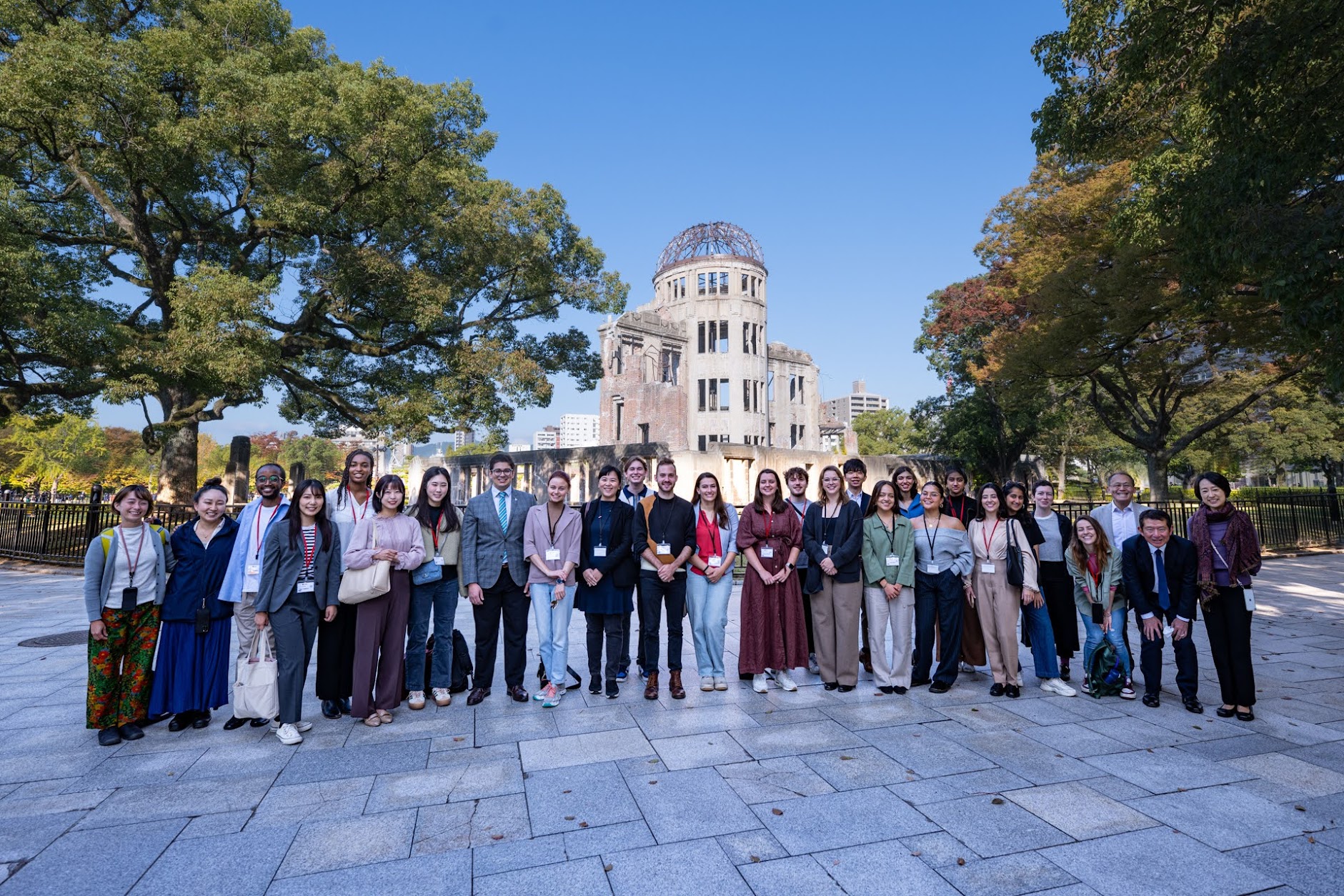
The New Voices on Nuclear Weapons Fellowship at the Federation of American Scientists helped me enter the field with no prior knowledge of nuclear weapons, let alone deterrence theory and the history of nuclear proliferation. I can confidently say that without this fellowship opportunity, I would not have thought I could have the authority to speak about nuclear weapons.
Many conversations and debates about nuclear weapons are rooted in complicated theories and hypothetical scenarios, making it difficult to join the discussion. While I believe it’s challenging for any human brain to fully internalize nuclear weapons’ lethal capacity, we can comprehend how nuclear weapons surpass the threats posed by other forms of warfare in terms of their destructive and indiscriminate potential.
I applied to the 2023 Hiroshima-ICAN Academy on Nuclear Weapons and Global Security to conceptualize the true destructive power of a nuclear weapon. Prior to the academy, I believed indisputable international norms prevented government officials from accepting disarmament and abolition as plausible nuclear policy guidelines. In speaking with hibakusha and many young activists in Japan, my preconceived notion was challenged; I learned that the propensity to dismiss the feasibility of nuclear abolition is not innate. Those who have experienced the apocalyptic repercussions of a nuclear weapon not only endorse the necessity of abolition but themselves underscore that the pursuit of disarmament is not just a policy objective but a moral responsibility—one that demands collective action and a commitment to preventing future generations from experiencing the unspeakable tragedies of the past.
The 2023 Hiroshima-ICAN Academy on Nuclear Weapons and Global Security is organized by Hiroshima Prefecture and the International Campaign to Abolish Nuclear Weapons (ICAN), the 2017 Nobel Peace Prize laureate. The goal of the program is to educate young leaders who can make concrete contributions toward a more peaceful and secure world. In addition to several peers from the United States, I joined other participants from China, Italy, India, Kenya, Lebanon, Ukraine, and more.
The 2023 Hiroshima-ICAN Academy hosted several online lectures and four days of educational sessions in Hiroshima, Japan. Online webinars gave participants the opportunity to interact with famous activists, such as Koko Kondo, Mary Dickson, and Melissa Parke, and hear from esteemed professionals in the nuclear field like Dr. Vincent Intondi and Izumi Nakamitsu. We learned about the suffering of downwinders in the United States, ICAN’s initiatives towards abolition, the UN’s disarmament efforts, and the racial history of nuclear weapons testing and usage. Prior to the online portion of the academy, I knew nothing of the intersectionality of nuclear weapons threats.
While in Hiroshima, we had a busy week of meetings, lectures, and tours, including a guided tour of the Peace Park and meetings with Hiroshima Mayor Kazumi Matsui, Hiroshima Governor Hidehiko Yuzaki, and atomic bomb survivor Keiko Ogura. Together, we learned about Hiroshima nonprofit efforts to support atomic bomb survivors, discussed the ecological effects and colonial history of nuclear weapons testing, and planned how to effectively interject discussions about disarmament in our respective communities.
The most memorable part of the ICAN Academy for me was speaking with atomic bomb survivors, also known as hibakusha. I was fortunate to spend several hours with hibakusha Ms. Sadae Kasaoka, who was 12 years old when the atomic bomb dropped. Ms. Kasaoka urged all of the Hiroshima ICAN participants to share her story with our communities.
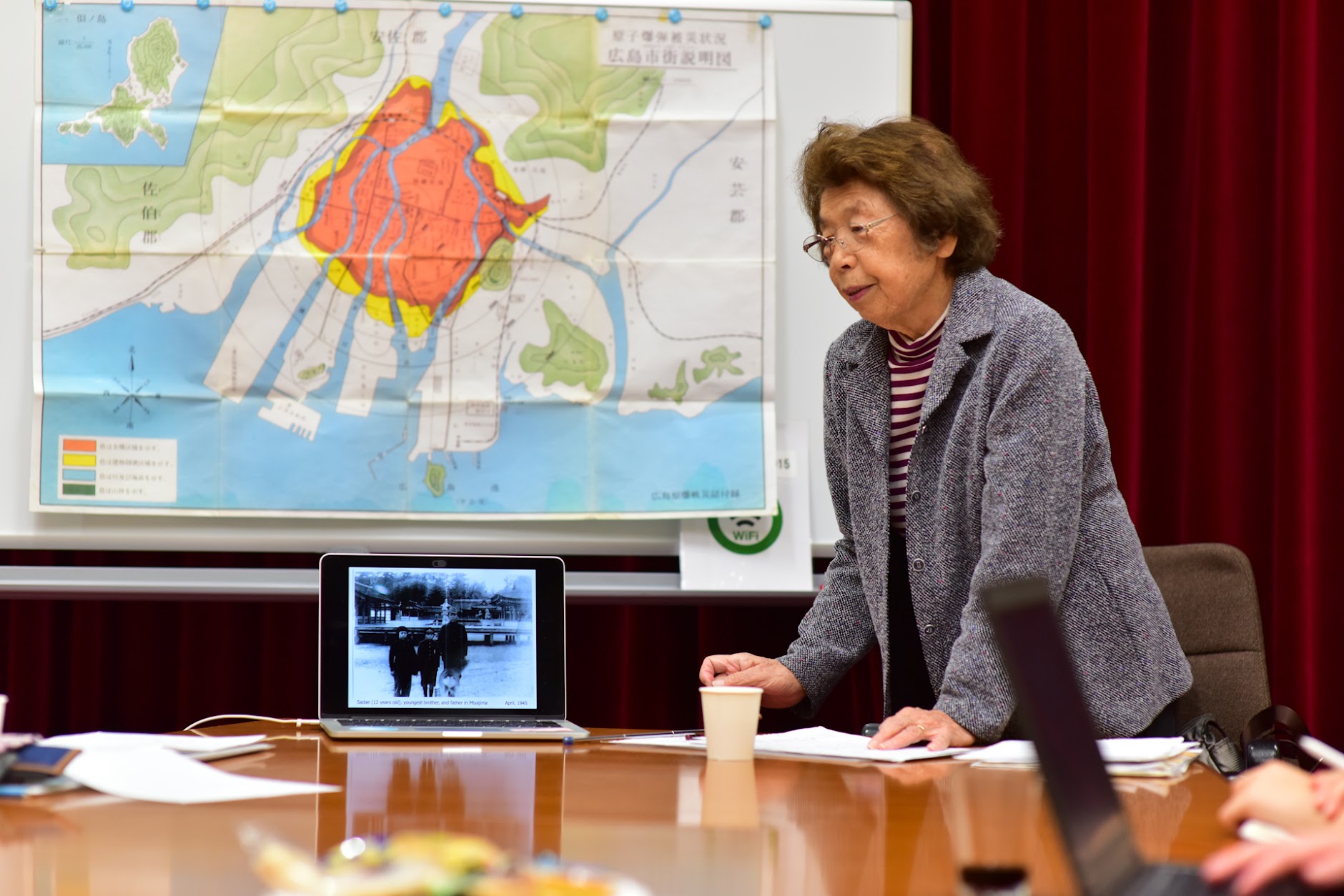
I was struck by Ms. Kasaoka’s bravery and resilience. No human wants to dwell on the most traumatic experience of their lives, let alone recount it for hundreds of listeners each year. However, Ms. Kasaoka has been doing so year after year for the benefit of our education.
Like many children in Japan during World War II, Ms. Kasaoka would help demolish wooden houses to prevent the spread of fire after air raids. Her life consisted of work, rushing to bomb shelters, and fearing for her family. On the morning of August 6, 1945, Ms. Kasaoka was in her home when the atomic bomb was dropped. Ms. Kasaoka saw a blast of light through the window of her home and was knocked down by the initial blast of the bomb. Hours later, the images she would see in her town would be seared into her memory forever.
During our conversation with Ms. Kasaoka, she recounted the destruction of her friends’ homes and vividly remembered watching humans walk up the mountain, skin hanging off of their bodies like ghosts. When her father was brought back to the house on a stretcher several hours later, she did not recognize him because his face had significantly swelled and his skin was burnt black. She would spend the next two days applying cucumbers and potatoes to his skin to cool the burning while picking maggots out of her father’s flesh as he pleaded with her for water. Later, she would be brought a bag of ashes and hair, allegedly belonging to her mother. The atomic bomb would leave Sadae Kasaoka an orphan like thousands of young Japanese children in Hiroshima and Nagasaki. In Ms. Kasaoka’s words, “This is the reality of war.” Her story is only one of hundreds of thousands.

Prior to my fellowship with FAS, like many young Americans, I believed that nuclear weapons were a rusting relic of the past. At the end of my fellowship, I recognize these weapons are being cleaned and shined as arsenals expand and the risk of nuclear weapons use grows to be higher than at any time since the Cold War. Both FAS and the ICAN Academy led to my realization of a sobering truth: nuclear weapons cannot coexist with mankind indefinitely.
The Federation of American Scientists values diversity of thought and believes that a range of perspectives — informed by evidence — is essential for discourse on scientific and societal issues. Contributors allow us to foster a broader and more inclusive conversation. We encourage constructive discussion around the topics we care about.
New Nuclear Bomb Training At Dutch Air Base
The Dutch air base at Volkel appears to have started integration training with the new U.S. B61-12 guided nuclear gravity bomb in 2021, even before the bomb went into full-scale production and entered the U.S. stockpile in 2022.
An image included in a Sandia National Laboratories video from early-2022 that snapshots accomplishments from 2021 shows what appears to be a B61-12 training shape hanging under the right wing of an F-16 (see image below).
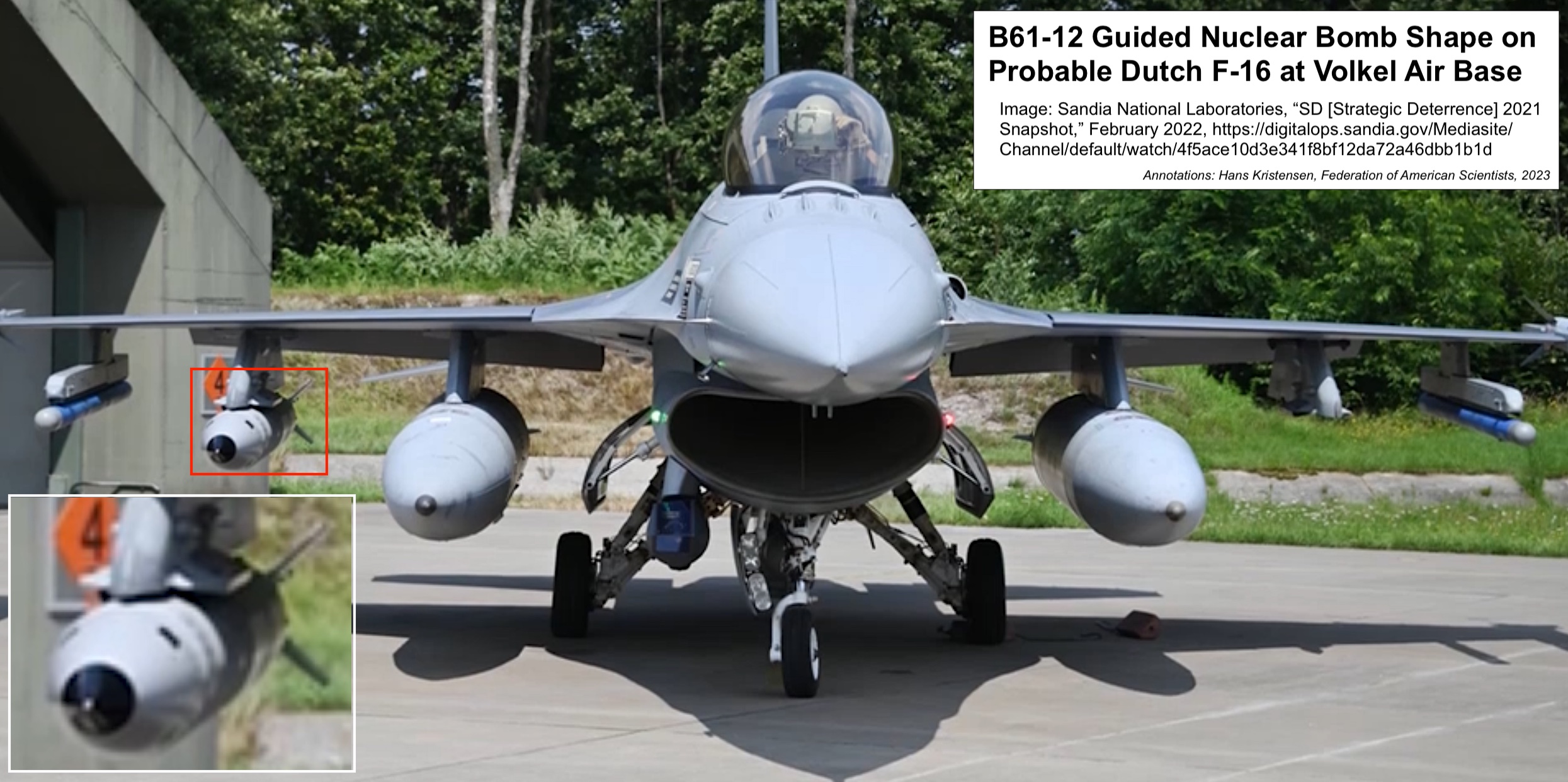
The Dutch air force apparently started training for the new U.S. B61-12 guided nuclear bomb in 2021.
The video does not not identify the location but the image appears to be from Volkel Air Base in the Netherlands; The design of the protective aircraft shelter visible in the photo is unique to Dutch shelters. Eleven of the shelters at the Volkel are equipped with an underground vault that can hold up to four B61 bombs. But normally they only hold 1-2 bombs each for an estimated 10-15 bombs at the base. A picture posted on a public forum shows the outline of a vault inside a Protective Aircraft Shelter at Volkel Air Base (see below).
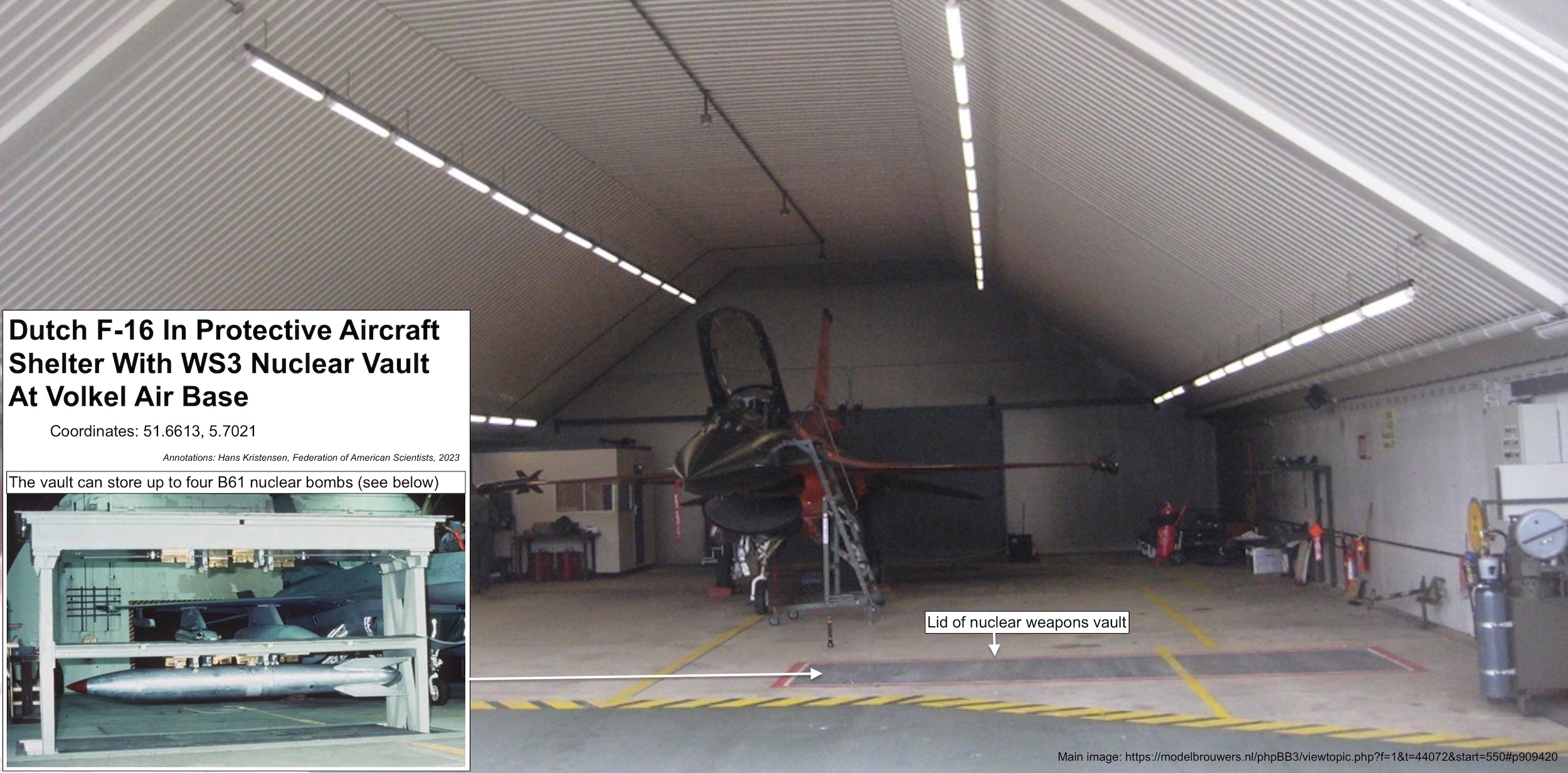
Eleven aircraft shelters at Volkel are equipped with an underground nuclear weapons storage vault.
Although the training B61-12 is mounted on an F-16, the weapon is not yet assigned to the NATO fighter jets. The B61-12 has entered the U.S. nuclear weapons stockpile, but it is so far only assigned to the B-2 strategic bomber, according to the U.S. Department of Energy. The fighter jets (F-15E, F-16, Tornado) have completed integration flights but had, as of recently, not yet been assigned the B61-12 (see table below). The new F-35A that will take over the nuclear strike role at Volkel and other European bases had also not been assigned the B61-12 yet, but U.S. European Command training was scheduled to start in 2023.
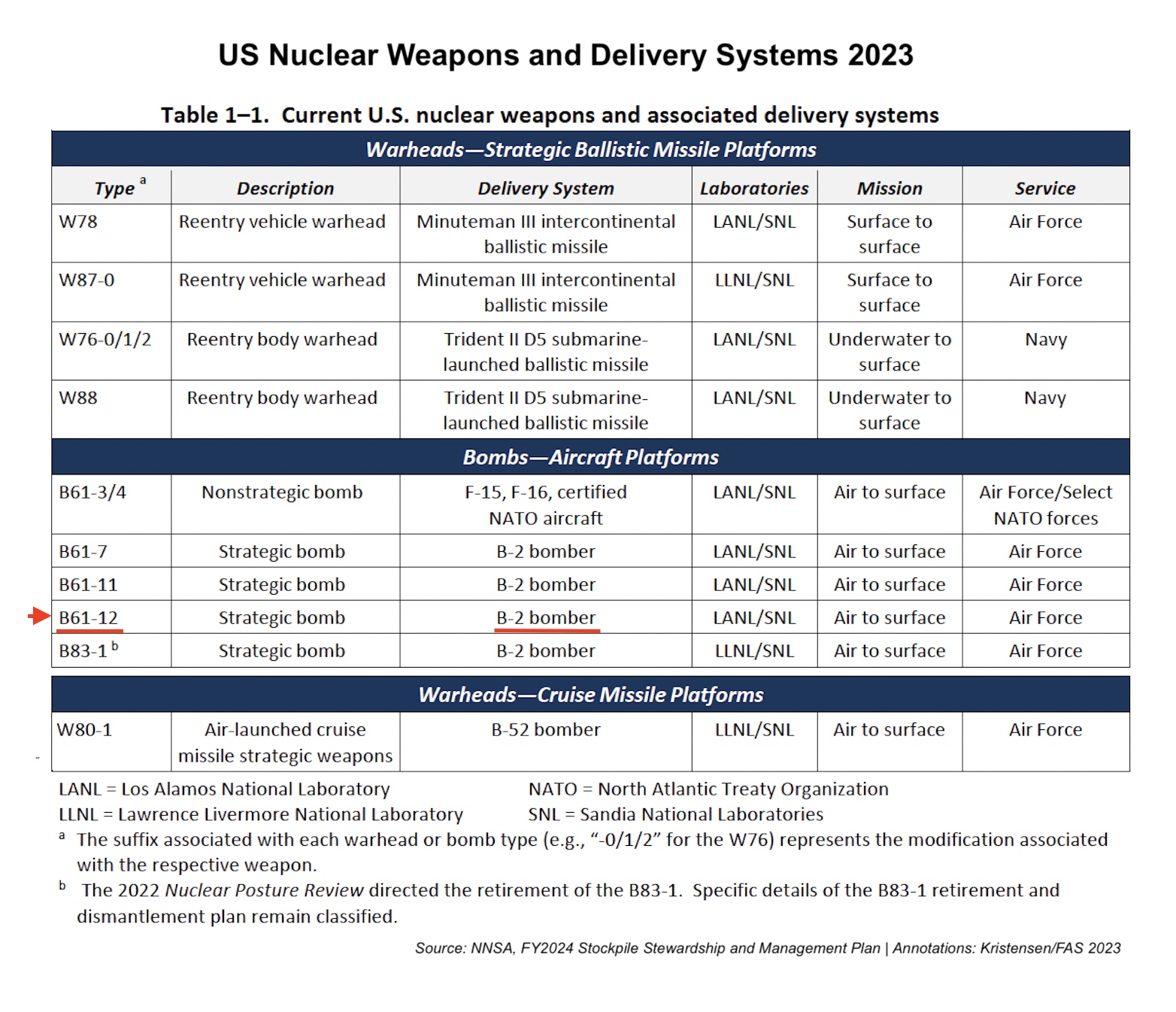
The new B61-12 nuclear bomb had, until recently, only been assigned to the B-2 strategic bomber not yet to dual-capable fighter aircraft.
The 312th Squadron of the 1st Wing at Volkel Air Base is part of the so-called NATO nuclear sharing arrangement where the United States equips Dutch F-16s (and aircraft of five other NATO countries: Belgium, Germany, Greece, Italy, Turkey) and trains their pilots to employ U.S. B61 nuclear bombs in war. During peacetime, the weapons are under the custody of U.S. Air Force units (the 703rd Munitions Support Squadron (MUNSS) at Volkel).
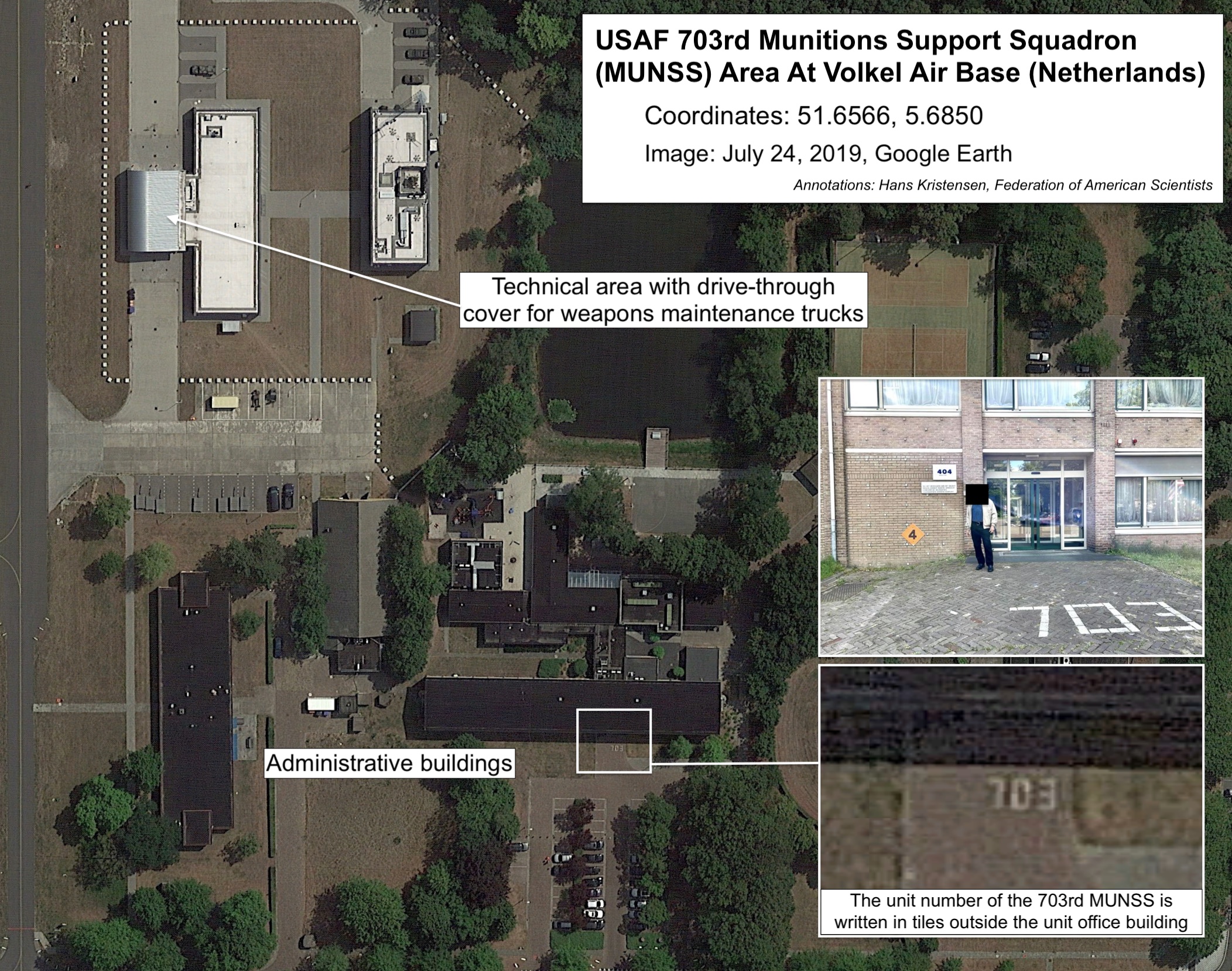
The location of the USAF nuclear weapons custodial unit at Volkel Air Base is written in tiles.
On December 8, 2023, the 312th Squadron performed what is known as an elephant walk where 14 F-16s were displayed on the runway at the same time. A similar display was performed in 2021. At least one of the pilots in the 2023 event can be seen wearing a helmet visor with a nuclear weapons explosion mushroom cloud (see image below). It is possible, but unknown, that this is the helmet of the commander of the 312th Squadron.
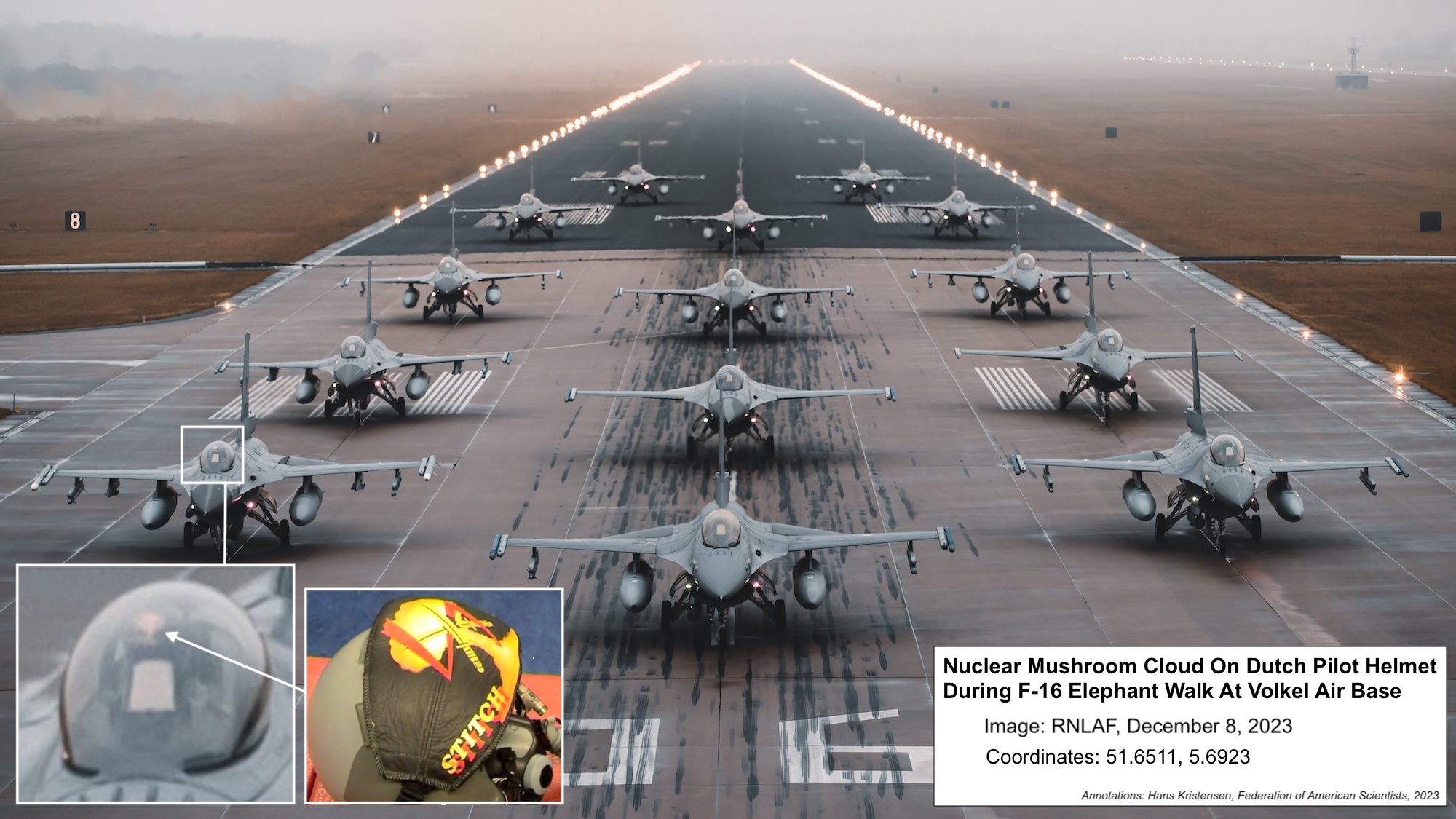
One of the pilots in the December 2023 elephant walk at Volkel Air Base wore a nuclear mushroom cloud design on his helmet visor.
The nuclear weapons upgrade at Volkel Air Base is part of a broad nuclear modernization program of U.S. non-strategic nuclear forces in Europe that includes replacement of aircraft, bombs, base infrastructure, nuclear command and control, readiness level, operational planning, and public visibility.
There is no public information that the B61-12 bombs have been shipped to Europe yet but the C-17A nuclear transport aircraft has been cleared and the first shipments could potentially begin next year. If so, they would replace the estimated 100 B61-3/4 nuclear bombs currently deployed in Europe (see figure below).
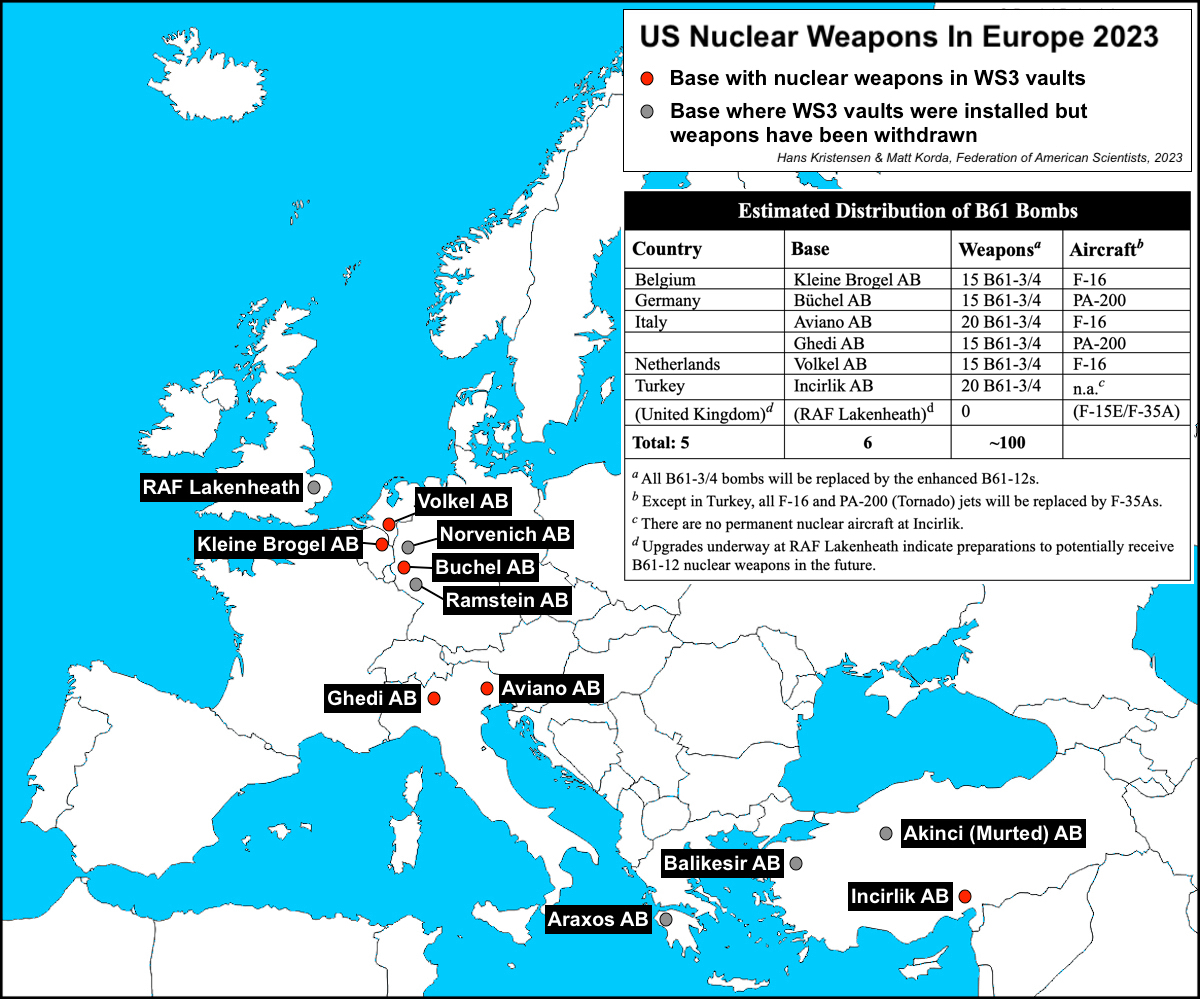
Additional information:
• Nuclear Notebook: Nuclear Weapons Sharing, 2023
• Increasing Evidence That The US Air Force’s Nuclear Mission May Be Returning To UK Soil
• The C-17A Has Been Cleared To Transport B61-12 Nuclear Bomb To Europe
• NATO Steadfast Noon Exercise And Nuclear Modernization In Europe
This publication was made possible by generous contributions from the New-Land Foundation, the Ploughshares Fund, the Prospect Hill Foundation, Longview Philanthropy, the Future of Life Institute, Open Philanthropy, and individual donors. The statements made and views expressed are solely the responsibility of the author.
TPNW2MSP: Overview and Key Takeaways
The 2nd Meeting of States Parties (MSP) to the Treaty on the Prohibition of Nuclear Weapons (TPNW) took place at United Nations Headquarters in New York City from November 27 through December 1. Participants in the Meeting included 59 member nations, 35 observer states, around 700 civil society registrants, members of the scientific community, and representatives of communities affected by nuclear weapons.
The Meeting culminated in agreement by states parties on a joint declaration and package of decisions. Arguably, the most significant outcome of the 2nd MSP was the consensus joint declaration challenging long-held assumptions of nuclear deterrence theory and affirming the security risks it poses.
What’s happened since the first MSP
The first Meeting of States Parties to the TPNW occurred in Vienna, Austria in June 2022, where states parties adopted the Vienna Action Plan. That plan listed 50 actions for States Parties to implement the TPNW and goal of global nuclear disarmament and created three working groups on disarmament verification; victim assistance, environmental remediation, and international cooperation and assistance; and universalisation. The Vienna Plan additionally created thematic focal points for gender and complementarity of the TPNW with other fora like the Nuclear Non-Proliferation Treaty (NPT). The working groups each met several times during the intersessional period.
The first MSP also created a Scientific Advisory Group (SAG) of 15 experts to study and provide scientific and technical expertise on a variety of issues related to nuclear weapons. The SAG is the first international scientific body formally created by a multilateral treaty process to promote nuclear disarmament. The group met nine times during the intersessional period to prepare its report to the second MSP, and its final report drew heavily upon research conducted by independent open-source analysts, including the Federation of American Scientists.
Several states have joined or taken action toward joining the treaty during the intersessional period. The Bahamas, Barbados, Burkina Faso, Djibouti, Equatorial Guinea, Haiti, and Sierra Leone signed the treaty; the Dominican Republic, Democratic Republic of the Congo, and Malawi ratified the treaty; Sri Lanka acceded to the treaty; and Indonesia, the fourth largest country in the world by population, recently enacted the TPNW into law within its parliament and is expected to soon complete ratification.
Nearly half of NPT states parties have now signed the TPNW, reflecting growing unacceptance of the lack of progress on nuclear weapons states’ Article VI disarmament obligations.
Noteworthy happenings during 2MSP
The 2nd Meeting of States Parties included a large number of national and other statements and reports. The proceedings notably included moving testimony from nuclear-affected communities, active participation and presentation of research by civil society, a report from the Scientific Advisory Group, notable observer state attendance, and statements from a group of parliamentarians from around the world and the financial community.
Impacted communities
One of the most important features of the TPNW is its focus on impacted communities. Participants and attendees included victims of nuclear testing in Kazakhstan, Kiribati, Marshall Islands, Australia, and French Polynesia; Hibakusha (atomic bomb survivors) from Hiroshima and Nagasaki; downwinders from the U.S. Southwest; and communities impacted by uranium mining.
Benetick Kabua Maddison, Executive Director of the Marshallese Education Initiative, delivered a joint statement to the Meeting on behalf of 26 affected community organizations and supported by 45 allied organizations that provided testimony of the harm of nuclear weapons and called for land remediation and universalization of the treaty.
Scientific Advisory Group
In addition to numerous civil society research presentations and statements throughout the week, the Scientific Advisory Group (SAG) presented its Report on the Status and Developments Regarding Nuclear Weapons to the Meeting. This presentation marked the first formal participation of the SAG in the proceedings of the TPNW following its formation.
SAG co-chairs Dr. Zia Mian and Dr. Patricia Lewis introduced the report to the MSP. The report, heavily citing the work of FAS’s Nuclear Information Project, included an overview of the global status of nuclear stockpiles, nuclear modernization, nuclear risks, humanitarian consequences, and disarmament verification. Additionally, the SAG recommended a global scientific study sponsored by the UN on the effects and consequences of nuclear war.
Observer states
Unsurprisingly, none of the nuclear-armed states attended, but several U.S. treaty allies – Australia, Belgium, Germany, and Norway – attended the MSP as observers. Two of the observers (Belgium and Germany) are part of the NATO nuclear sharing arrangements to deliver U.S. nuclear weapons in times of war.
The delegate from Norway made a statement in support of NATO as a nuclear alliance: “Norway stands fully behind NATO’s nuclear deterrence and posture, including the established nuclear sharing arrangements.” According to some analysts, this may be the first time Norway has explicitly supported U.S. nuclear weapons deployments in Europe in a multilateral disarmament forum. This continues a trend of increased support of NATO nuclear missions by Norway since the end of the Cold War, which has recently included participating in joint exercises with US B-52 bombers and a US B-2 bomber landing in Norway for the first time.
The German delegation similarly supported NATO’s nuclear mission in its statement to the Meeting while criticizing Russia’s announcement of nuclear weapons deployments to Belarus. The representative stated that “confronted with an openly aggressive Russia, the importance of nuclear deterrence has increased for many states, including for my country.”
Three observer states to the first MSP were notably absent from the second: The Netherlands, Finland, and Sweden. The Netherlands is the only NATO member to participate in the initial negotiations of the TPNW. Despite this, the Netherlands has consistently voted against UNGA resolutions welcoming the adoption of the TPNW, and, after the first MSP, the Dutch Foreign Ministry reported that continued observation of TPNW proceedings “is not useful.”
Finland voted against the UNGA resolution on the TPNW for the first time in 2022 and chose not to observe the 2nd MSP, possibly due to its recent NATO membership. Sweden similarly voted against the resolution for the first time in 2022 and was absent from the 2nd MSP. These actions by Sweden could be related to its bid for NATO membership and its brand new Defense Cooperation Agreement with the U.S.
Points of tension
Although states parties came to agreement on a final declaration and package of decisions (with the MSP even closing around two hours earlier than scheduled on the final day), there were some points of disagreement and division throughout the week.
One primary disagreement was on nuclear sharing – particularly how strongly the final declaration should condemn it. European states parties pushed back on forceful language to prevent their regional allies and the U.S. from being implicated in the condemnation that they wanted centered on Russia’s nuclear deployments to Belarus. The final joint declaration avoided mention of specific sharing arrangements and simply included a condemnation of and call to cease all such arrangements.
In a similar vein, some states like South Africa wanted to include strong language on the Comprehensive Test Ban Treaty (CTBT) that would condemn both Russia’s recent de-ratification and the fact that the U.S. has never ratified the CTBT. U.S. allies at the Meeting, however, wanted language focusing solely on Russia’s actions. Ultimately, neither country was identified by name in the joint declaration; instead, states parties made a broad call for all countries to sign and ratify the CTBT and promote its entry into force.
Unique participants
Alongside states parties, observer states, and civil society groups, the TPNW 2MSP included participation from a diverse, global group of parliamentarians as well as representatives from the financial community.
A delegation of 23 parliamentarians from 14 different countries, including US Rep. Jim McGovern (D-MA), delivered a statement to the Meeting urging governments (in some cases their own) to join the treaty.
The financial community provided a statement to the MSP on behalf of over 90 investors to promote collaboration between states parties and the financial community to divest from the nuclear weapons industry.
Results of the MSP: Final declaration and decisions
The Meeting of States Parties closed on Friday, December 1st around 4:30 PM after consensus agreement on a joint declaration and package of decisions.
Through the joint declaration, states presented their consensus view that nuclear risks are growing due to the actions of nuclear weapons states: “Nuclear risks are being exacerbated in particular by the continued and increasing salience of and emphasis on nuclear weapons in military postures and doctrines, coupled with the on-going qualitative modernization and quantitative increases in nuclear arsenals, and the heightening of tensions.”
States parties additionally declared the catastrophic humanitarian effects of nuclear weapons as the central impetus for pursuing and achieving global nuclear disarmament, spotlighting the human and environmental costs to argue that “the only guarantee against the use of nuclear weapons is their complete elimination and the legally binding assurance that they will never be developed again.” States jointly rejected any normalization of nuclear rhetoric and identified nuclear threats and deterrence as security risks, declaring:
“The threat of inflicting mass destruction runs counter to the legitimate security interests of humanity as a whole. This is a dangerous, misguided and unacceptable approach to security… Far from preserving peace and security, nuclear weapons are used as instruments of policy, linked to coercion, intimidation and heightening of tensions. The renewed advocacy, insistence on and attempts to justify nuclear deterrence as a legitimate security doctrine gives false credence to the value of nuclear weapons for national security and dangerously increases the risk of horizontal and vertical nuclear proliferation… The perpetuation and implementation of nuclear deterrence in military and security concepts, doctrines and policies not only erodes and contradicts nonproliferation, but also obstructs progress towards nuclear disarmament.”
On nuclear sharing, states parties called on all states with nuclear arrangements, including extended nuclear security guarantees, to cease all such arrangements and join the TPNW. They also reaffirmed the complementarity between the TPNW and the NPT and called out the lack of progress nuclear weapons states have made toward their NPT Article VI obligations on disarmament.
The package of decisions included an agreement by states parties to collaborate in challenging false narratives of nuclear deterrence by engaging in and promoting scientific work on the humanitarian consequences of nuclear weapons. This collaboration includes the establishment of a consultative process on security concerns of states to advance arguments against nuclear weapons and nuclear deterrence.
States also agreed to engage in discussions on establishing an international trust fund for victim assistance and environmental remediation. Lack of progress and vague phrasing on such a trust fund is likely due to disagreements on whether or not non-states parties to the TPNW should be able to contribute to the fund. Some states fear non-states parties could use their contributions to the trust fund to avoid strong pressure to join the treaty.
Next steps for the intersessional period
The Third Meeting of States Parties to the treaty will take place in 2025 from March 3 to 7, again in New York.
During the intersessional period, the informal working groups established by the Vienna Action Plan will continue to meet, and focused discussions will take place in order to present a report to the third MSP on the feasibility and guidelines for an international trust fund.
States parties and signatories will engage in an intersessional consultative process along with the Scientific Advisory Group, International Committee of the Red Cross (ICRC), International Campaign to Abolish Nuclear Weapons (ICAN), and others with the aim of providing a report to the third MSP containing arguments and recommendations to promote a counternarrative to nuclear deterrence rhetoric.